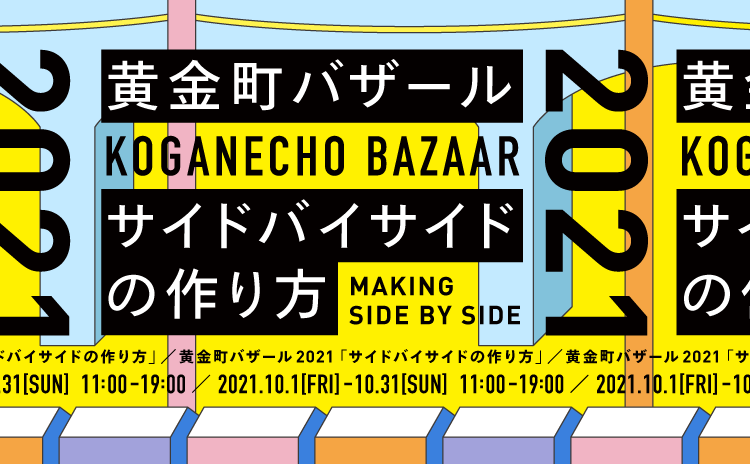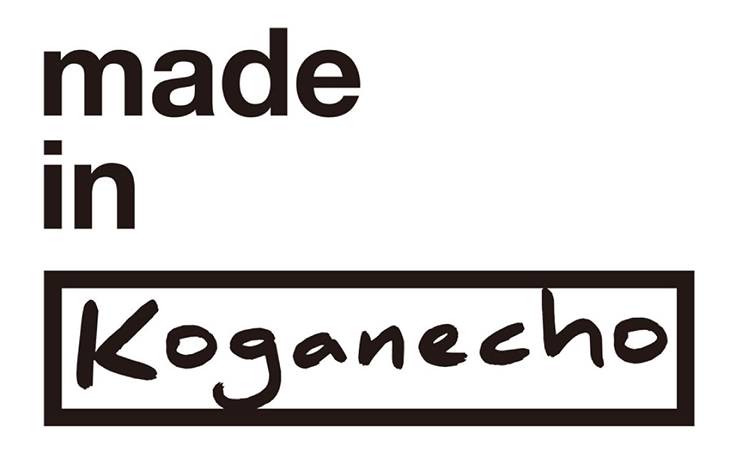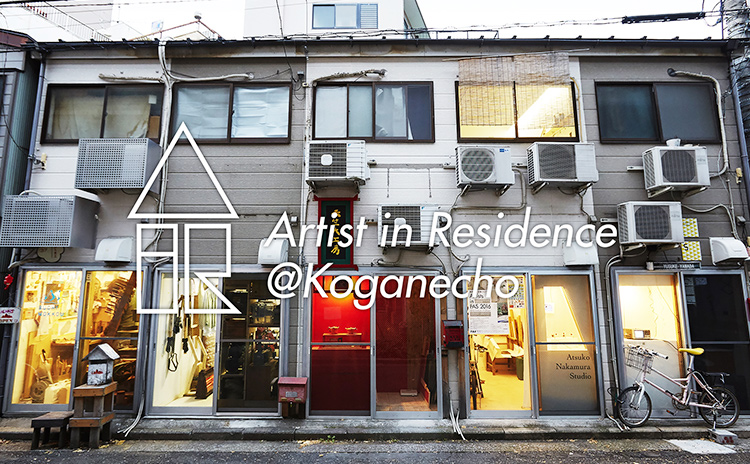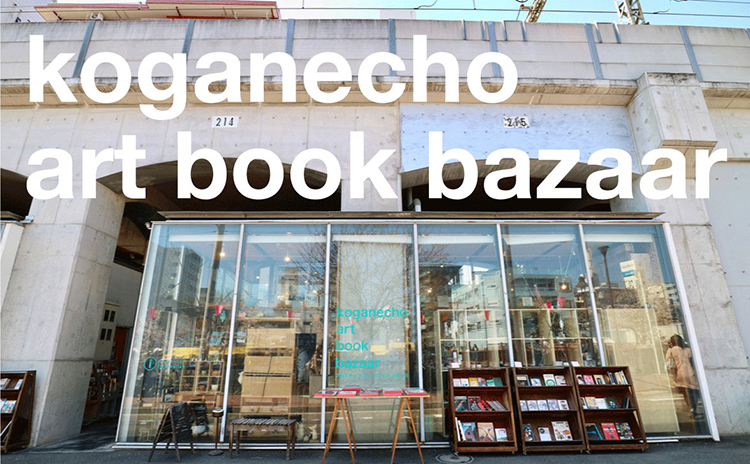Art and Community: A Practice in Koganecho, Yokohama
Chapter 2: Tracing the Past
From the Museum City Project to Koganecho
Shingo Yamano
2-1 Tokyo
Bigakko (1969)
After graduating from high school, I went from Fukuoka to Tokyo and entered an art school, “Bigakko” that opened that year. It was a small school started by Gendai Shicho-sha, a publisher of unique and cutting-edge books at the time, and was located near Yotsuya Station (Wakaba-cho, Shinjuku-ku) in the first year, but moved to Kanda Jinbo-cho in the second year. In addition to practical courses in art, the school featured classroom lectures by a diverse group, including literary scholars, artists, and thinkers who drew on the publisher’s personal connections, making it a rather unusual school even for its time. Most universities were still in the midst of school conflicts, and of course Bigakko were not unrelated to such social trends, but they seemed to be more of a gathering place for university students and dropouts who were out of the mainstream and had nowhere else to go. (*1) It was also distinct from so-called art schools, and there was a mix of students who were not particularly interested in art. Rather few of them went on to pursue art after graduation and the personnel seemed to have scattered into various fields. Although there were some surprisingly academic courses besides those on Dadaism and Surrealism in the classroom, due to the variety of lecturers, lectures were not only about art. However, surprisingly, given the historical background of the time, none of the content was political. For a young man from a country side, it was my first opportunity to meet writers and thinkers I had only known through books, as well as artists who were active on the front lines. The organizers, such as Yoshihiko Imaizumi and Hiroshi Kawani, also had strong personalities.Young people of this era, including myself, were in the habit of reading books, magazines, and manga of all genres, watching movies that came to the second or third run repertory theater, and even going to see Butoh or plays if we could financially afford it. So rather than feeling a genre barrier at the time, it was more like an age of trivia, where everyone was interested in everything. Art students were aware of new trends in contemporary poetry, and poets were art critics, theater critics, film critics, and manga critics at the same time. Bigakko itself was more than an art school; it was a mix of all these genres. In the first year, Yosuke Inoue’s manga class, which I had hoped to take, was not offered (due to lack of enrollment), and instead I was enrolled in Shoji Yamakawa’s drawing class. The main content of the class was to copy illustrations from old Western books with a mapping pen. In a sense, the class followed the policy of Bigakko, which was to have students acquire skills through repeated copying rather than creating some kind of artwork. If students wanted to create their own works, they were free to do so on their own. Yamakawa, the teacher was not so busy as a storyteller at that time, but when he had work to do, he gave his students the experience of working as assistants by turns. In later years, I came to understand Mr. Yamakawa’s technical skills, but at the time, I was not an enthusiastic student, and the first year ended without acquired much technical skill. I remember exhibiting a pen drawing in the style of William Blake at a graduation exhibition held at the Geijyutu-seikatsu Gallery (*2).
“The 10th Tokyo Biennale- Between Man and Matter” and the Second Year of Bigakko

The following year, I decided to stay at Bigakko and attend the copperplate printing class of Mitsuo Kano. In May 1970, I went to the Tokyo Metropolitan Art Museum in Ueno to see the “The 10th Tokyo Biennale- Between Man and Matter” exhibition. It was an exhibition that I had never seen before. I am not sure how much I understood the works at the time, but after seeing this exhibition (which was actually a traveling exhibition that would never tour, and I later saw a smaller version again in Fukuoka), I began to think about trying my hand at contemporary art. However, there was a considerable gap between this new glimpse into the world and the copperplate prints I began to study at that time. I began by imitating Mr. Kano, but I could not achieve anything satisfactory in terms of both technique and content. Eventually, I began to experiment with a kind of conceptual art that used printmaking techniques to consider the relationship between words and matter. I cannot recall why I became interested in conceptual art. It may have been the “Between Man and Matter” exhibition. Or maybe it was an art magazine of the time. It was not due to the influence of Yutaka Matsuzawa. Teacher Matsuzawa always gave classes at the same time of day in the next room, which was partitioned off and completely beyond my understanding. I doubt if I even used the term “conceptual art” at that time. I was creating works that combined words and figures. From Mr. Kano’s point of view, I think I flunked out of school. I thought of myself as someone who was far removed from the framework of Bigakko. In the end, what I learned from Bigakko was to choose the path of self-education. After completing Bigakko I stayed in Tokyo for a while, but my desire to become an artist grew stronger, and I decided to leave Tokyo, where I was at a financial standstill, for the time being and return to Fukuoka (*3).
(*1) In my first year, I started a poetry journal with Haruyoshi Tamura, a former Bigakko classmate, and Tsutomu Kurao, a student at Kokugakuin University, both of who were the student at Tanabe High School in Wakayama Prefecture. Tamura later became a used book dealer and published an antiquarian book magazine called “Housho Gekkan”. He died in 2011. In addition to his self-published poetry collections and novels, he left behind a book titled Editor-in-Chief of Housho Gekkan (Shobun-sha, 2002). This book also contains a few memories of Bigakko. Kurao died much earlier in 2002, but Tamura made a posthumous collection of his poems.
(*2) A book titled Bigakko 1969-2019: Jiyu to Jikken no Akademeia (Liberty and Experimentation Academia) (Shobun-sha, 2019) was published about Bigakko, but the description of the early days of Bigakko, including Yoshiko Shimada’s writings and others, is not enough in terms of the total volume of the book. Although my own recollection is included in the book, I am not confident that my memories are accurate. In addition, you can find more details by referring to the special issue on Yoshihiko Imaizumi in Kikan published by Mokuma Kikuhata. Tamura’s Hosho Gekkan March 1998 edition is the special issue entitled 30 Years of Bigakko. Also, in English, Anti-Academy (John Hansard Gallery. University of Southampton, 2013), describes the early days in Bigakko by Yoshiko Shimada and William Mariotti, together with the comments by early Bigakko instructors including Hiroshi Nakamura, Genpei Akasegawa, Mokuma Kikuhata, Natsuyuki Nakanishi, and Yutaka Matsuzawa.
(*3) In the late 1990s, Bigakko was facing a financial challenge. In the midst of all this, Yoshihiko Imaizumi retired in 2000, and Kozo Fujikawa took over as principal. I took charge of one of the classes, and ended up helping restructure the school. It was my idea to invite young artists as instructors, so I asked Tsuyoshi Ozawa to join, although knowing that he was busy. I expected that he could bring several instructors to join him. My class was called “Art Project Lab” and lasted from 2000 to 2011. I was paid at first, but became unpaid in the middle of the year. It took more time to improve the management situation of Bigakko.
2-2 Fukuoka
From Copperplate Print Lab to IAF Art Lab
In 1971, I moved back to Fukuoka. First, I stayed at my parents’ home, then moved to Tani 2-chome, Chuo-ku, Fukuoka City. The name of the place used to be “Ronindani“(Masterless Samurai Valley) and I guess it used to be just like the name of the place. On one side, there was a maze of slopes where houses were densely built. Follow the flat road and you will hit the Faculty of Liberal Arts of Kyushu University, then turn right, you get to the intersection of Ropponmatsu. Near the intersection, Nobuo Sukehiro, who graduated from Bigakko, ran a used bookstore. However, by the time I moved in, he had already moved his store to another location. Kozo Fujikawa started working at the used bookstore as a staff. Nobuo Sukehiro helped me make my first contacts in Fukuoka, including people from the Kyushu-ha (Group Kyushu) and Kazuyoshi Shinkai, who eventually became like my mentor.
I think I was introduced to Mokuma Kikuhata by Sukehiro, because I did not have any former contact with him at Bigakko. I visited Kikuhata’s home with him. There was a small restaurant called “Sanae” near the Faculty of Liberal Arts of Kyushu University. I was taken there by Sukehiro, who told me that Group Kyushu’s member sometimes came there. It was probably here where I first met Takami Sakurai and Osamu Ochi, the leaders of the Group Kyushu. Kazuyoshi Shinkai was a kind of student of Mokuma Kikuhata and was known as a radical man. I had no recollection of being his student, but Shinkai took the liberty of thinking of me as his student. He would suddenly call me up in the middle of the night, make me pay for his drinks, take things from my house, etc. He gave me a hard time, but when his death approached, he gradually became kinder and began to pay for his own drinks. (Actually, he should not have been allowed to drink because he had stomach cancer, he often vomited while drinking.) (*4)
My father bought me a copperplate press I used for my own work for a while. As an extension of my pre-completion work at art school, I was making works that were a combination of multicolor figures using a combination of letterpress and intaglio, as well as works that were only letters. At the time, there seemed to be no place in Fukuoka other than universities that taught copperplate printing, so in 1975, I opened a copperplate printing class in a part of my residence in Tani 2-chome. At that time, my brother introduced me to Keita Egami, who had just graduated from Tokyo National University of Fine Arts and Music and returned to his parents’ home in Ōmuta city, and together with others who gathered at the class, we made a small art criticism magazine. Together. we decided to expand the art, set up some other classes, and rented the second floor of a wooden house in Yakuin 3-chome, Chuo-ku, Fukuoka city to restart the art classes. After a while, I gave the place the name “IAF Art Laboratory,” which stands for Institute of Art Function. Eventually our group became known as IAF.
When the school was established, the instructors were Yamano (etching), Egami (drawing), Koichi Ogawa (silkscreen), and later, Tadahiro Kizuka (oil painting, drawing), Inoue Akira (lithography), Rokuro Tasaki (silkscreen, replacing Ogawa), and Sumio Tahira (tempera) joined (*5).
This new location began to attract young artists and students from the art department of Kyushu Institute of Design. Most of them were not IAF students, but began to gather on days when there were no classes and after class, buying beer and food and staying late into the night, sometimes until morning, to discuss the issues (*6). It was under these circumstances that Tadahiro Kizuka proposed a study group on contemporary art. (*7) At first, we started with modern art and studied by ourselves, but that seemed to be too much, so we asked Akio Obigane, then curator of the Fukuoka City Museum of Art, to serve as instructor. The first text he chose was a thick book titled Minimal Art: A Critical Anthology (edited by Gregory Battcock) and each student took turns to translate part of the text and present it once a week with Obigane correcting translation errors and explaining his interpretations; this became the basis for our discussions. This reading group started in October 1979 and ended in March 1981. Next, we discovered conceptual art, and began reading On Art, Artists: Writings on the Changed Notion of Art After 1965 (edited by Gerd de Vries) an anthology about the same volume as the minimal art book.
This study group continued even after Obigane left Fukuoka. It was followed by a conceptual art study group with the participation of Akihiko Morishita, an assistant at Kyushu Sangyo University using texts from Art & Language, The Anti-Aesthetic reading group with the participation of Raiji Kuroda (Fukuoka City Museum of Art), and a semiotics study group using texts by C.S. Peirce and Mikhail Bakhtin. As we had more and more opportunities to work with the people who gathered at these study groups, we came to be regarded as one of the young artists’ groups (*8)
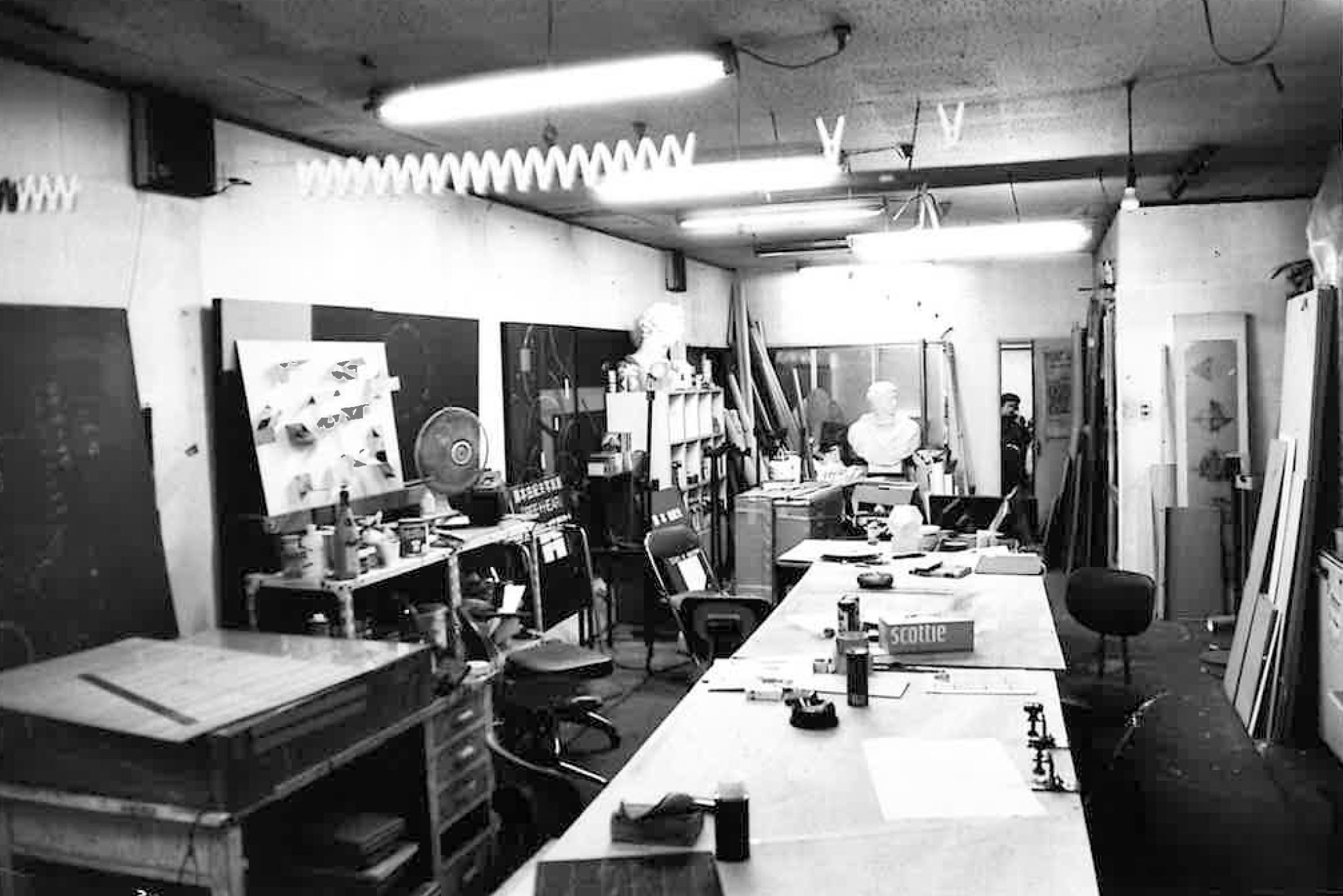
Photo: Hiroyuki Nagahama
We participated in group exhibitions organized by other young artists and organized our own (*9). At the time, experimental film was flourishing in Fukuoka. There was a private group called FMF (Film Makers Field), and the Department of Visual Communication Design at Kyushu Institute of Design, led by Toshio Matsumoto, attracted young talented people and students. Under their guidance, we also made 8mm films and they participated in our exhibitions. In 1987, IAF started a video art class by Yoshihiko Noto, a member of FMF, using video equipment, not film (*10).
IAF became known as a place for film screenings and performances, and it also became a stopover for artists from Tokyo and other regions who visited Fukuoka, and in later years, even artists from Asia.
(*4) I found a handwritten manuscript on the back of a flyer from the early 1990s and it titled “Kyushu-ha Koza Yowa – Shinkai Kazuyoshi no Koto” (An anecdote for a lecture on Group Kyushu- about Kazuyoshi Shinkai).
The following is a summary of the second half of the manuscript.
“He seemed to me to be the embodiment of the Group Kyushu thesis that “life is art”. He was a kind and gentle man when we were talking alone, but when we were in a situation in a group gathering, his tone became sharp and harsh, as if he were beating up some unfortunate victim in the public eye. He did this to me several times. I sometimes feel as if he entrusted me with something on my own, and feel as if I must respond to him. In his late years, he had become a generous person, as if he had vanquished the bad memories of his past. I used to be his extortionist, but he began to treating me. Mr. Takami Sakurai teased me, saying, “You are the only one who can get Shinkai to give money.” On the other hand, when Mr. Sakurai gave me a copy of his book, The Road to Paradise, I was chided by Shinkai for not paying him properly. He also chided me for not visiting him once when he was first hospitalized. The last time I went to the hospital, he was lying there, skin and bones, unable to move, but greeted me with a smile. When I left the hospital room, I saw that he was sad to see me go. I regretted not holding his hand then. We parted so easily.”
(*5) The desks in the art classroom are modeled after those at Bigakko. In the opening year, we organized an exhibition of the miniature painting studio of Bigakko at IAF. At first, we were thinking of using the space as a gallery. At that time, a young artist group called Zodiac was active in Fukuoka. Among the instructors of the class, Koichi Ogawa, Tadahiro Kizuka, Akira Inoue, and Rokuro Tazaki were members of the group. The group is listed on Wikipedia as “Zodiac (avant-garde art group)”. It was active for a fairly short period of time, from 1977 to 1978, holding a series of exhibitions, then after which it seems to have split up as a group.
(*6) The first student to come to IAF was Isao Sakata who was the student of Kyushu Sangyo University, Faculty of Art, Department of Photography. He later brought other students with him. Sakata was enthusiastic about his work and graduated from IAF in 1981 with his self -organized “Sakata Isao Printmaking Class Graduation Exhibition”. He died a few years later in a traffic accident.
(*7) At that time, books were ordered from Art Vivant, a bookstore located at the corner of Sezon Art Museum in Ikebukuro, Tokyo. About the text of first study group is based on Keita Egami’s memory. There was another book with a black cover called Conceptual Art, but that is no longer in IAF. There was also a collection of Donald Judd’s complete works, which, according to Egami, I bought for them.
(*8) Among the members of the group at that time who continued to work as artists afterwards were Chiaki Wada and Tomoko Ushijima, both from Kyushu Sangyo University. Hatsune Miyamoto (a medical student at Kyushu University at that time), who later became an administrative staff member of the Museum City Project, came to IAF for the first time in 1984 for taking an interview for a magazine she was publishing with her club. She also said that before that, some students from the art club of Kyushu University coming to IAF to learn silk screens prints making.
(*9) Kazunari Takamuku, a classmate of Kizuka’s at Kyushu Sangyo University, ran a snack bar called “Eve’s Apple (Ivu-no Ringo)” near Hakata Station. It too had become a hangout for young artists. In 1980, he came up with a plan to organize a cross-section of artists’ groups in Fukuoka, including Kiyoshi Hasegawa and Kizuka from a young artists’ group Zodiac, Yoshihiko Noto from FMF, Michihisa Nagasaki, Nobuo Arita, Katsumi Hirosue, Naohide Yamazaki who were the lecturers at Kyushu Sangyo University, Yamano and Egami of IAF and Takamuku himself to participate, but in the end Kiyoshi Hasegawa did not attend. The group disbanded after two exhibitions, ” The Will of Method” (1980) and “The Will of Method II” (1981).
(*10) This description is based on the chronology in the pamphlet of an exhibition IAF 1989. One of the students at that time was Naoko Tosa, who later became media artist. I also remember that the main members of FMF at that time were Yoshio Fukuma, Yasuko Miyata, Yoshihiko Noto, and Yoshiaki Yoshizumi. The publisher is listed as Fukuoka, but there is no mention of its location. FMF was formed in 1977 by Yoshio Fukuma, Yoshihiko Noto, and Junichi Morita. According to Ririe Maeno, in the chapter of IAF and FMF, the lectures were held twice a week for five months from October 1983 to February 1984, that consisted with the courses on Visual theory (Akihiko Morishita), Photography (Yoshiaki Yoshizumi), Video (Yoshihiko Noto), and Film (Yoshio Fukuma). The second term of the course was held from April to August 1984, with five students in the first term and two in the second. (This does not match the description in IAF 1989. Akihiko Morishita’s text in IAF 1989 stated that there was a video course by Yoshihiko Noto. (I am not sure now, so I will leave the aforementioned sentence as it is.) Yoshio Fukuma was born in 1953 and passed away in 2007. Akihiko Morishita of Kyushu Institute of Design played an important role in connecting the film and visual art scenes in Fukuoka, but before that, he probably played a key role in connecting the university and private sector in the film industry. There was a time in Fukuoka when everyone knew each other and had easy time collaborating, and he was probably one of the benefactors who created such an atmosphere.
Tadashi Kawamata
In 1983, Akio Obigane contacted me to help him find a location for an exhibition for Tadashi Kawamata who was planning to install the work outside the museum. That was my first encounter with Tadashi Kawamata. At that time, Obigane was planning an exhibition called ” Material and Space” which included artists such as Shigeo Toya and Toyomi Hoshina and featured a new form of art that was rapidly gaining attention – installations.This new concept of installation brought by Kawamata had a big impact on young artists in Fukuoka. For an artistic concept to change means that the concepts of reality around art also change. Kawamata had a great influence on me and Keita Egami in particular. After Kawamata, the young artists in Fukuoka changed. They (or rather we) began to take our work outdoors. We began to hold exhibitions in places that weren’t galleries nor museums – on rooftops of buildings, in empty houses, offices etc. Things also became more fast paced. We started holding exhibitions on almost a monthly basis. During this time, not only our generation but also younger people already became more active. (*11)
(*11) The relationship between Kawamata and IAF continued, even as he was making silk screen works at the request of places like Art Front Gallery and Gallery Kobayashi. In the latter half of 1990, Kawamata once again came to Fukuoka. “Coal Mine Tagawa” was a long-term project to build a steel tower in a coal mining town, and Kawamata came to stay and work on it twice a year while also working on other related projects. He started the project with the help of young artists and architects, then later many people became involved as staff and volunteers. In 2006 the project ended, with the steel tower left uncompleted.
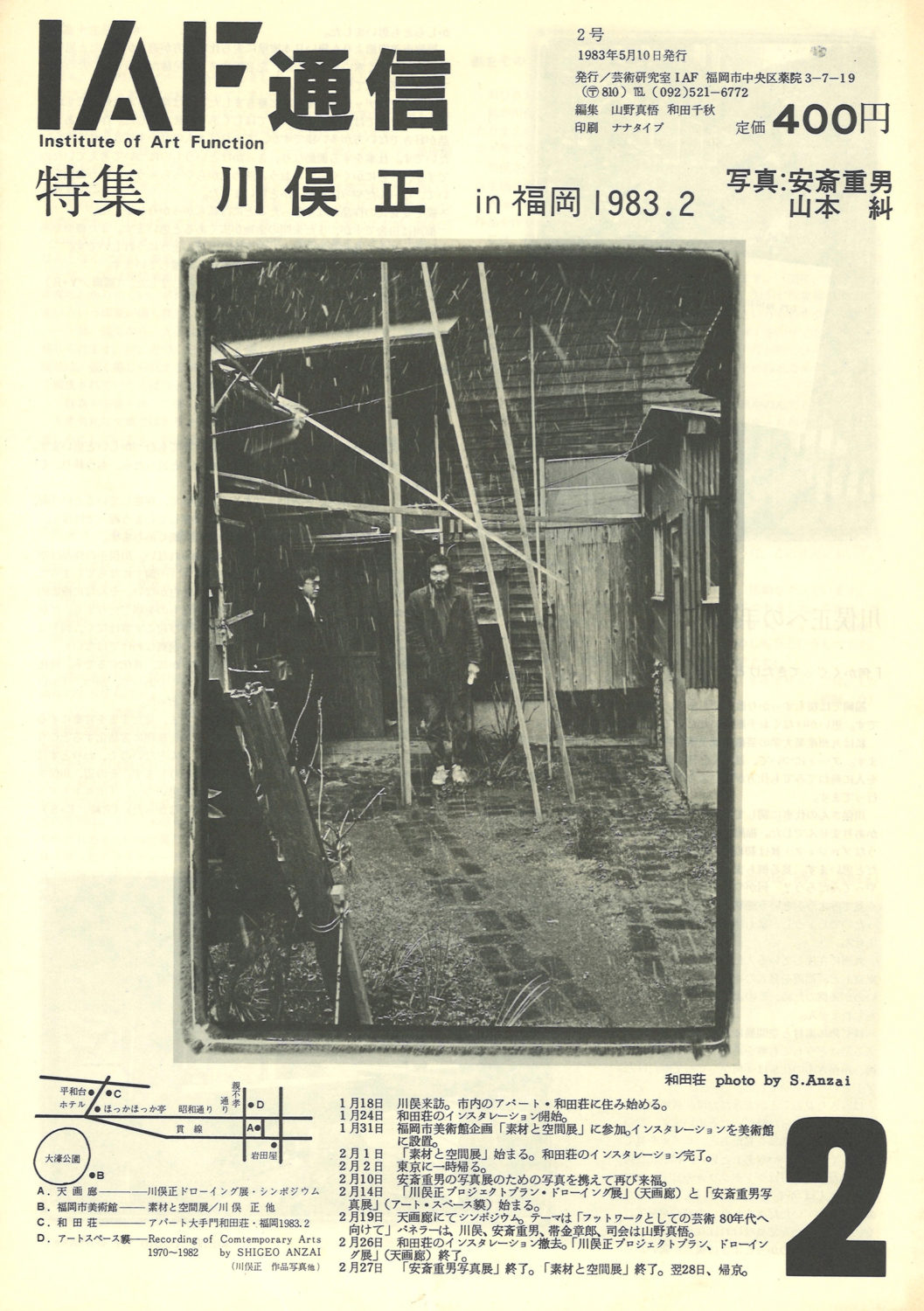

IAF News Letter No. 2 “Special Issue on Tadashi Kawamata” and No. 3 “Special Issue on Shigeo Toya.”
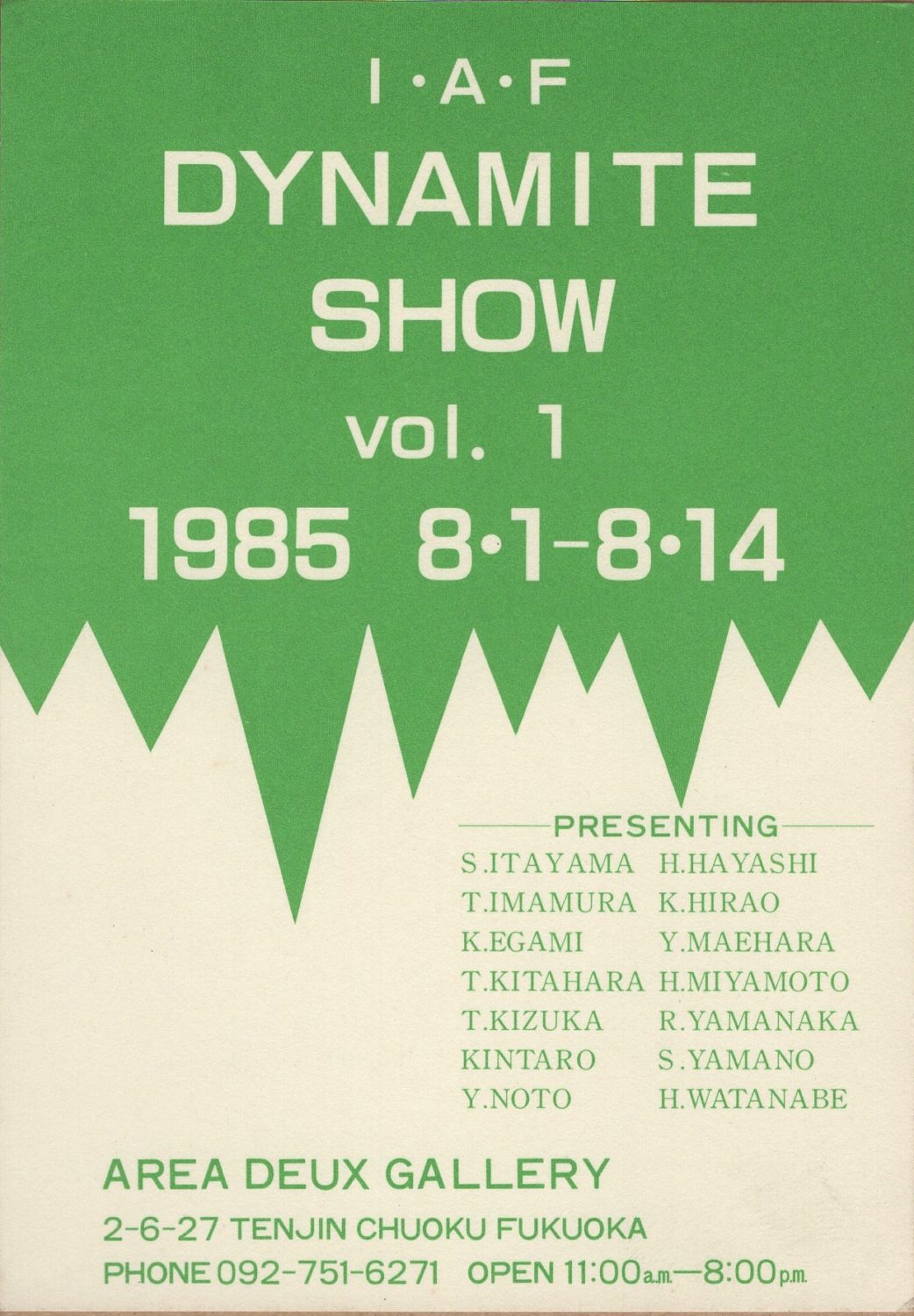
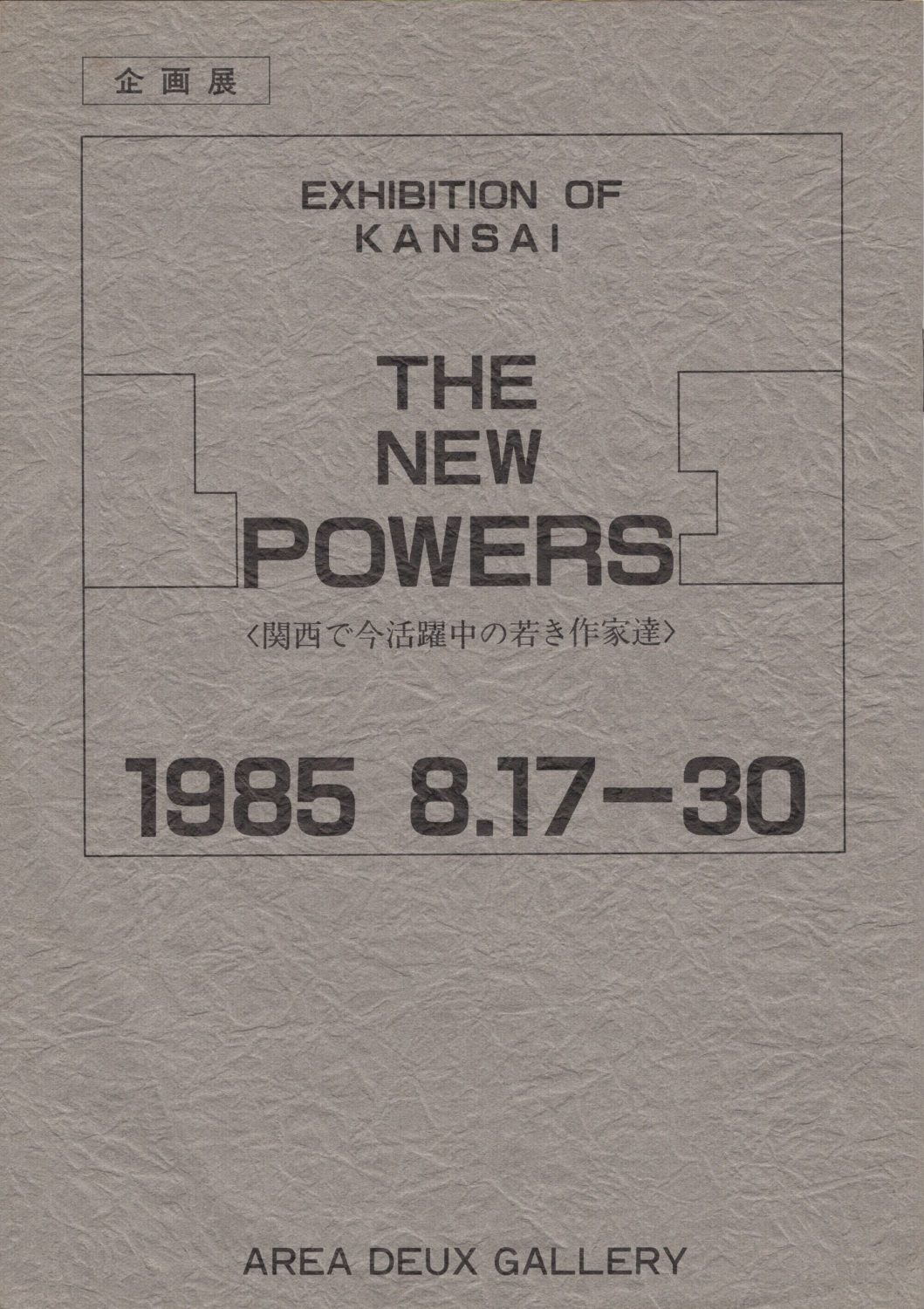
Left: IAF’s group exhibition “Dynamite Show” at Area Deux Gallery
Right: “The New Powers” introducing Kansai New Art
Artist Network
Since 1983, due to encountering Kawamata, who organized his projects moving from place to place, we began establishing networks with different places. Motoi Masaki, who was the curator of the Hokkaido Museum of Modern Art at the time and helped Kawamata with his project in Sapporo, supported us and this made a big difference. We began building a network in relatively nearby area of Kyushu, connecting local areas with each other (*12). In 1985, a commercial facility, Area Deux, affiliated with a local company Iwataya was established, and the Area Deux Gallery was opened there. It was a pioneering space in Fukuoka that was neither a rental gallery nor a commercial gallery, but rather a space that provided support to businesses, and our activities were aided in many ways.
In 1987, artists from Fukuoka, Gunma, and Hokkaido gathered at the Sagacho Exhibit Space, Tokyo, and held an exhibition called “Artist Network.” In the same year, an expanded version “Artist Network Expanded,” was held at the Fukuoka Prefectural Art Museum with the participation of artists from the Kansai region. The connections that were made at this time became the foundation for subsequent activities.
(*12) The first three small group exhibitions were held in Fukuoka, Kumamoto, and Oita under the name of “Various Forms Exhibition” (Tasu-Tayohtai-Ten). Later, in 1984, under the title of “Various Forms Exhibition in KANSAI”, a total of 98 participating artists exhibited their works at several venues in Osaka and Kyoto. From this period, the younger generation, including Hatsune Miyamoto and Hiroshi Watanabe, began to showcase their own original projects and artworks.
“GAS” Exhibition
In 1989, over 80 designers, illustrators and artists took part in the “GAS” exhibition (GAS stands for Global Art Stage) at Hotel Rich Hakata, which was then scheduled for closing, near Hakata station. Initially, the hotel commissioned designers and illustrators, then later invited visual artists, so it ended with many artists including IAF members. The main venue was a vacant former music classroom on the second floor of the hotel, approximately 900m2. The exhibition was held from August 1 to September 30, 1989. The number of participating artists continued to increase during the festival period. In addition to the musical events, the hotel operated a beer bar. (*13)
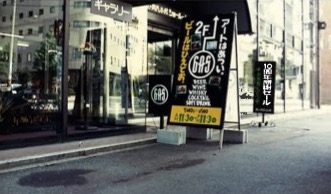
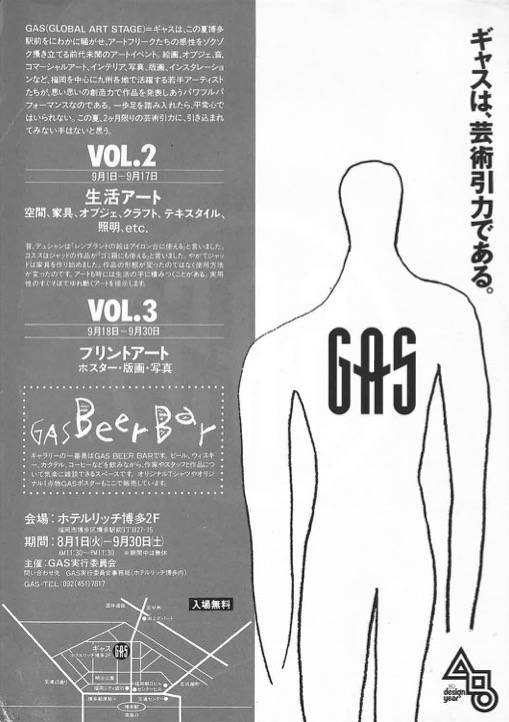
(*13) I found the second GAS flyer, white text on red. On the right shoulder of the reverse side was writing that reads “GAS is an Artistic Gravity”. The flyer seems to have been a special feature of the exhibition, as it indicates “Lifestyle Art, Spaces, Furniture, Crafts, Textiles, and Lighting” from September 1 to 17. Underneath, there is a short text that reads, “Duchamp once said that Rembrandt’s paintings could be used as an ironing board. Kosuth said that Judd’s work could be used for trash cans. Eventually Judd started making furniture. It wasn’t the form of the artwork that changed, but changed the way it was used. Art, too, sometimes inhabits the hands of life. I present art that oscillates right alongside practicality”. Obviously, I am the writer of this. Vol. 3 is from September 18 to 30 and that reads “Print Art: Posters, Prints, and Photographs.” No text is attached to this.
I think Vol. 3 is fine, but Vol. 2 is a plan I might have mentioned, and I doubt if it was really approved. Below the title, a hand written style logo says GAS BEER BAR. A number of designers and illustrators were involved, so I don’t see any design difficulties at all. This is accompanied by text. “At the far end of the gallery, there is GAS BEER BAR, a space where you can casually chat with the artists and staff about their work over a beer, whiskey, cocktail, coffee, etc. Original and one-of-a-kind posters are also available for sale here. The food and beverage space were operated by the hotel staff. I remember that the exhibition was open from 11:30 A.M to 11:30 P.M a day, and people were making a big fuss until midnight. I think this is the Fukuoka style. In the March 1990 issue of De Arte published by the Kyushu Art Association, I wrote a report on the event and described it as a pioneering example of cooperation with a company, its purpose promoting exchanges between contemporary art and neighbourhood. But both of these statements sound like an afterthought.
Kyushu Contemporary Art Adventure
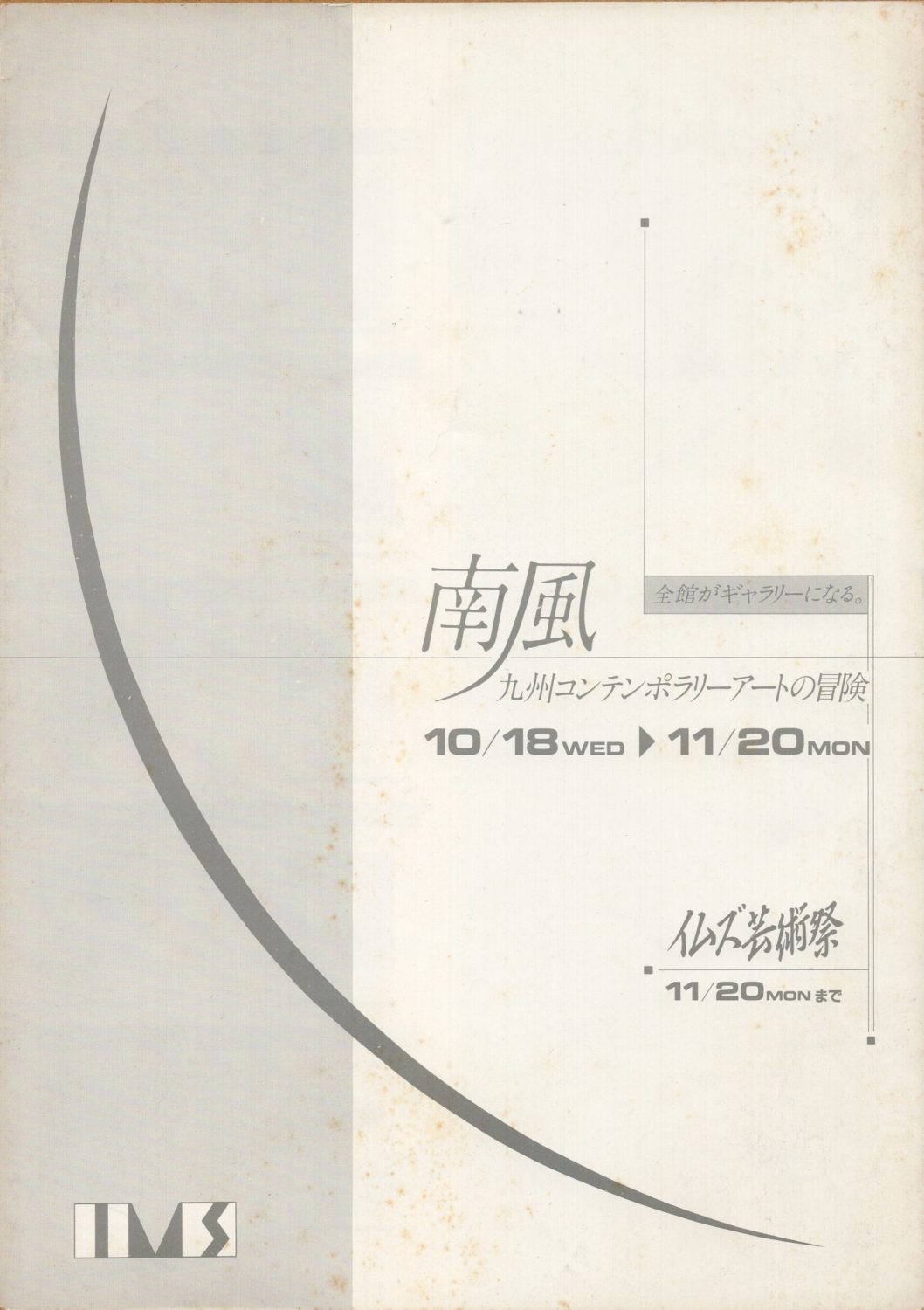
During this exhibition a couple of people came to see me. They were Shotaro Tsuji from Mitsubishi Estate and Nobuyuki Harada from Nishinippon Newspaper. Tsuji was managing the new IMS mall which had just opened in Tenjin in Chuo ward in Fukuoka that year. Harada had just begun managing Mitsubishi’s Art Gallery Artium. The two approached me as those responsible for culture in the IMS building, and asked whether I would be able to make use of the entire IMS building to put together an exhibition with local young artists. I accepted. This was my first experience trying to put together an exhibition while managing a budget. In 1989, the first “Kyushu Contemporary Art Adventure” was held, with 15 artists from Kyushu area. Thus began my connection with the commercial facility (*14) That exhibition was held 10 times until 1998. From the third exhibition, artists were selected by open call, and it became a gateway for young artists. In 1999 we held a special “Kyushu Contemporary Art Great Adventure” and invited six local artists who had been part of the project in the past, as well as Tetsuya Nakamura from Tokyo and Natasha Nisic from Berlin as guests for the final exhibition in the series.
(*14) My role in Fukuoka changed dramatically when I began working with Shotaro Tsuji and others at I MS. I became an organizer of exhibitions in commercial facilities and working commissioning artists.
Subsequent IAF Activities
Into the 1990s, the focus of my activities shifted from the IAF to a new project called the Museum City Project (MCP). Although IAF still operated as an art class, for me it was mostly an office and a place of exchange. IAF never worked out in terms of management. We never made an income out of it that would cover the rent, and until the end, I had to manage it while making a living elsewhere.
If I were to summarize IAF’s accomplishments, I would say first that it became a place where Fukuoka’s young artists could gather, study and present their work, and that it became a place of exchange for artists from many places, including Asia. Although I may have found myself comparing MCP with IAF and keeping them separate, the work of IAF continued into the 1990s. There was a series of IAF Special Lectures, which were held at facilities in Fukuoka city (mainly the Fukuoka City Health Promotion Support Center, Airefu) and featured invited guests. According to the materials, in 1995, the IAF established a membership system with an annual fee of 3,000 yen, and the special lectures were started for the members’ benefit. The first course was a photography course by Michiaki Yoshizumi. This was held at the Modern Art Bank Wald, a gallery in Chiyo-machi. The second lecture was given by Cai Guo-Qiang at Airefu, Fukuoka City’s Health Promotion Support Center.
Current documentation shows that they held 31 of these lectures between 1995 and 1998, but it seems they continued after this as well.
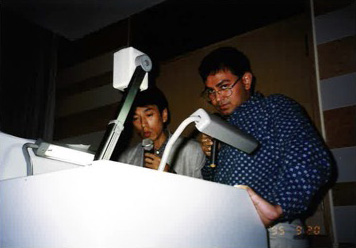
As a report on these lectures, a small handwritten booklet called IAF Paper was made for the members, which was then copied and distributed in small numbers. These have become a valuable resource for understanding Fukuoka’s art situation of the time. In 2001, after I managed to secure a new office in Hakata in Fukuoka, IAF was taken over by Yasuomi Unno and his associates who changed the interior and renamed it IAF SHOP. In 2004 management changed again to Keiichi Sato, and as of 2020 it is continuing as a place where people can eat and drink, see exhibitions and live performances.
2-3 Museum City Project
What is the Museum City Project?
The activities that came to be known collectively as the Museum City Project (MCP) in 1991 began in 1990 and continued until 2006. The exhibition entitled “Museum City Tenjin (or Fukuoka)” was held once every two years, and continued from 1990 to 2004. In addition, “Chinese Avant-Garde Artists Exhibition: Exceptional Passage” in 1991 and “WochenKlausur: Proposals and Practices through Art” in 1999 were held in the intervening years. In addition, a large-scale workshop event “Art Picnic” was held at the entire Fukuoka Boat (boat race track) in 1995 and 1996. Thereafter, MCP conducted experimental projects such as “Tenjin Art School”, “Art Bus”, “Art Hotel” and “Art Center” on a one-off basis. There was a plan for MCP sought to establish a full-scale “Art Center” to consolidate and sustain these activities, but this ended up being only a plan.
“Museum City Tenjin ‘90: Circulation of Sensibility Visual-City, Functioning Art ” (1990)
During the first “Adventures of Kyushu Contemporary Art” exhibition, I suggested to the people at Mitsubishi Estate of IMS (Shotaro Tsuji and his boss at the time, Yasuhiko Muramatsu) that we try expand this into the entire city (meaning Tenjin area). They simply replied, “Let’s do it.” Or perhaps IMS had a cultural strategic plan for the entire Tenjin area before I proposed the idea. Preparations began with plans to hold the event the following year. I don’t think I had the personal connections at that time, so I think the people at IMS were responsible for the initial organization. The “Museum City Tenjin Executive Committee (the original name)” was formed by people from business, government, media, and art, and was chaired by Kimiyo Sasaki, editor-in-chief of “City Information Fukuoka” (*15). The Project Management Office was set up at Planning Shuko-sha, which published “City Information Fukuoka,” and the main members were Hiroyuki Nagahama, an employee of that company, Hatsune Miyamoto, who was an artist at the time, and myself. The contents of the exhibition were mainly confirmed after consultation between myself and Raiji Kuroda, curator of the Fukuoka City Art Museum at the time. We also negotiated the participation of artists. Kuroda compiled the thematic text. Nagahama came up with the title “Museum City Tenjin”. In 1991, the organization name and the project as a whole became “Museum City Project.” At the time, I set a time frame of 10 years. I envisioned a story in which the relationship between the city and the art would gradually develop, and then as a result, would come to recognize each other, and change into something different from what they were.
However, 10 years was too short as it required much longer time.
One of the external factors at the time this project began was the major changes in the city. The redevelopment of the central area of Fukuoka city had created a number of new commercial facilities, each with its own hall, gallery, and other cultural facilities. Our project began in tandem with this trend, but at the same time, we could not have put the project together without the cooperation of local long-established businesses. Initially, the local Iwataya Department Store took the initiative and acted as a bridge between us and the Nanasha-kai, a group of major companies in Fukuoka at the time. Although each company received the project differently, the fact that Iwataya’s involvement helped us greatly for not to be turned away at the door. However, the bursting of the bubble economy and the movement of the new town associated with the redevelopment of the area resulted in the ironic outcome that long-established companies like Iwataya were driven to exhaustion and bankruptcy, while at the same time our project came to an end.

It could say that it began with the economic flow and ended with the same flow. It was a time when the concept of a Creative City as we know it today did not exist, and the idea of examining the art in relation to the city was not yet fully recognized.
In 1990, “Museum City Tenjin ‘90: Circulation of Sensibility-Visual City, Functioning Art” (*16) began as an exhibition event in a commercial area with no residents. Fifty-three artists exhibited their works in over 100 locations. The exhibition periods were scattered according to each commercial facility’s event schedule. This was a reckless project that no one had ever undertaken before. From the time it began to the ended, something kept happening without a break. I often found myself stuck at the office phone all day long.
The first exhibition was a mixed bag of success and failure, and although it could never be called a success, it was a big hit in Fukuoka as an unprecedented exhibition. It was the first encounter between the city and art, both for us and for the audience, and I saw great potential in the future of this experiment. (*17)
(*15) The Executive Committee was formed in consultation with Daihachi Hirokawa from Fukuoka City Planning Division (then) and Nobuyuki Harada of the Nishinippon Newspaper. In 1991, Zenichi Nakamura (ZEN Environmental Planning) became the chairperson of the Committee and Kimiyo Sasaki was the vice-chairperson, followed by the establishment of the Management Committee in 1998, with Shingo Yamano as the chairperson and Hatsune Miyamoto as the secretary general.
(*16) In 1990, “Museum City Tenjin” did not have middle dot.
(*17) There were not many foreign artists participating, so I asked an advice to Osamu Ikeda, who was then the director of Hillside Gallery. He told me about a Chinese artist, Cai Guo-Qiang coming to his gallery recently, and told me that he was an artist who used dynamite, not gunpowder. I had never seen his work or anything at all, but the word “dynamite” alone motivated me to try to work with him. I also have a draft letter to Anselm Kiefer in my notebook from that year, but I am not sure if I really sent it out.
“Exceptional Passage: Chinese Avant-Garde Artists Exhibition” (1991)
Cai Guo-Qiang, a participating artist in 1990, came to Fukuoka empty-handed. He then lived in my house and began to work slowly. When crop circles appeared in the neighborhood, he went to see them.
At that time, he already suggested me a next project idea. He proposed me to hold an exhibition in Fukuoka to introduce contemporary Chinese art with Fei Dawei, who was living in France at the time, to curate the exhibition. Fei sent me the list of his past projects and information on potential artists. We decided to proceed with this project together with Mitsubishi-Jisho, Artium, a gallery in IMS.
Fei Dawei came to Japan once before the exhibition for a meeting and the site inspection. For the outdoor venue, he wanted to use the former Kashii train yard (Higashi Ward, Fukuoka city), which was owned by the Japanese National Railway Settlement Corporation at the time, and we were able to rent it with the condition that if the project would be organized by Fukuoka city. Fei selected five Chinese artists, each of whom was active in different country. The name of the country in parentheses indicate where they lived at the time. Cai Guo-Qiang (Japan), Huang Yong-Ping (France), Gu Wenda (USA), Yang Jiechang (Germany), and Wang Luyan (China). Fei Dawei made the exhibition titled “Exceptional Passage”. This was a term he often saw when he came to Japan. According to him, it meant “a special passageway” (*18).
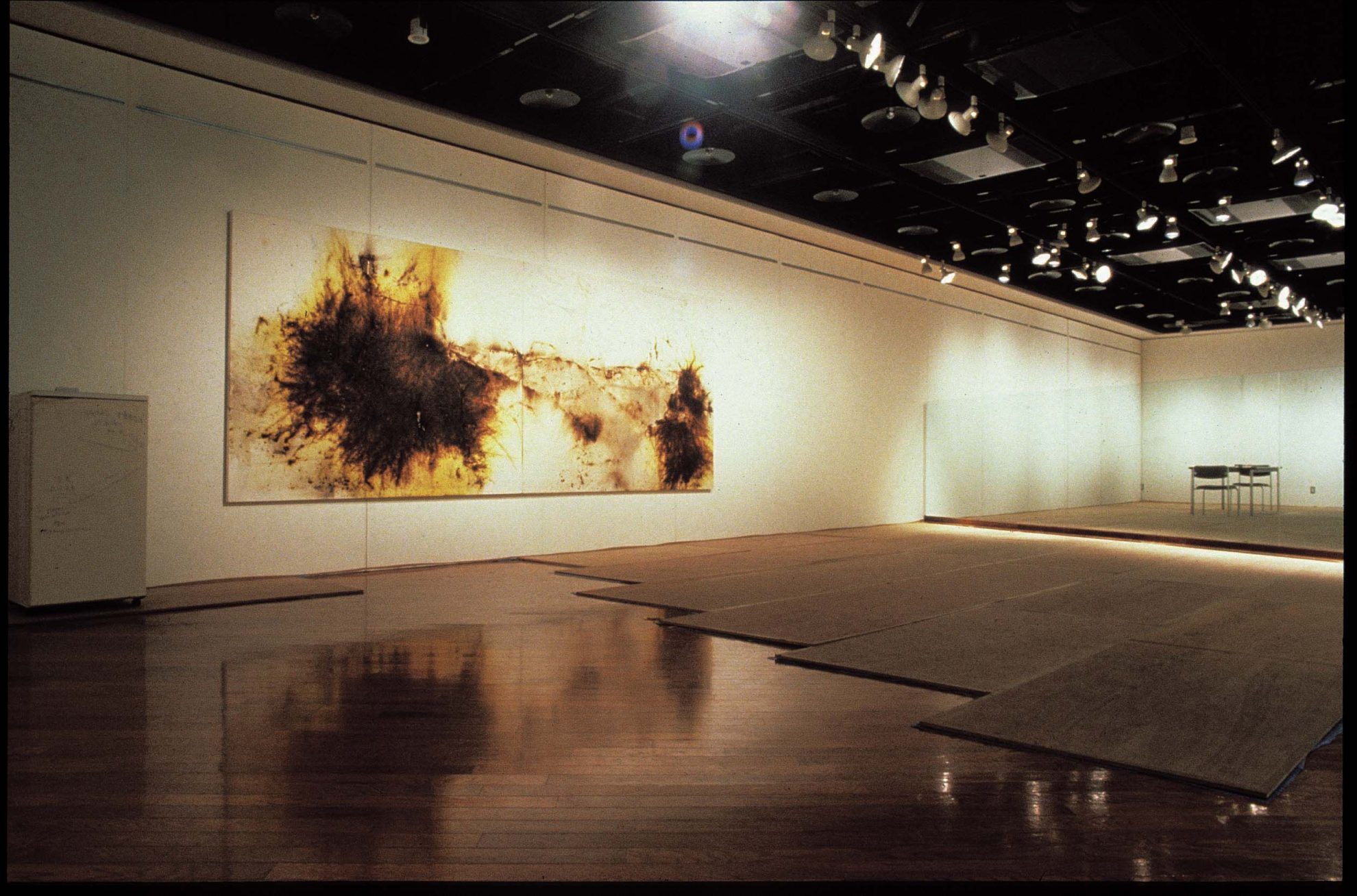
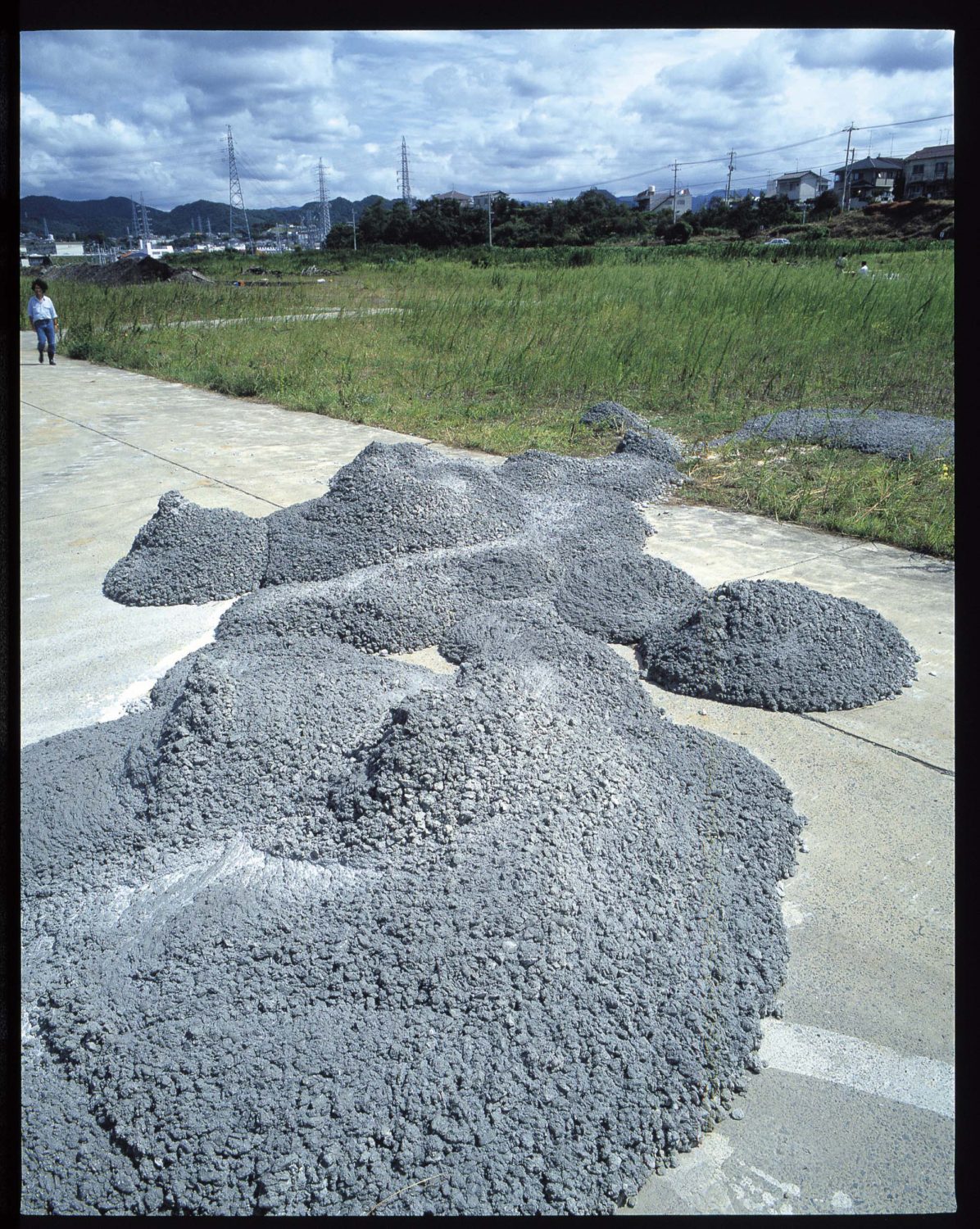
I received a lecture on the history of contemporary Chinese art from him. At the end of the 1970s, an awareness of contemporary art emerged that was distinct from socialist realism. In the beginning, information was limited to somewhat older periods such as Dada and Surrealism, but with the development of the open-door policy, Chinese artists quickly caught up with the contemporary art discourse in the West. In 1979, “The Stars” guerrilla style exhibition was held in front of the National Art Museum of China in Beijing. It is now known as a pioneering contemporary art exhibition. Many of its works were strongly political in nature. A new development took place.in 1985. It began with independent exhibitions held in various parts of the country, triggered by fierce criticism of the state-run art exhibitions. Led by a series of events, known as the “85 Art Movement” or the “New Wave Art Movement”, contemporary art in China entered into a new phase in which the artists began to examine artistic issues instead of simply dealing with political ones.
In 1989, the first nationwide contemporary art exhibition, “China/Avant-Garde” was held at the National Museum of China in Beijing. “Magiciens de la Terre” featured some Chinese contemporary artists, held in the same year at the Centre Georges Pompidou in Paris, marking the beginning of the recognition of Chinese contemporary art abroad.
In 1989, a cultural blockage occurred that ran counter to the economic open–door policy, but regardless of the changes in external conditions, it was Fei’s opinion at the time that the art movement was coming to an end. Thereafter, artists’ activities became more personal, and more artists went abroad in search of opportunity to exhibit their works. This phase is the background of the “Exceptional Passage” exhibition. Fei and the five guest artists began to camp out in my house. This was not planned but was the result of various budget cuts.
The artists were required to make sure that the indoor and outdoor exhibits were interconnected. They repeatedly submitted their plans for feedback by Fei. I requested to approve the details including the costs. Wang Luyan gave up the outdoor exhibit and produce only works for Artium as a group called the “New Measurement Group”, that he co-founded with Chen Shaoping and Gu Dexin. The works by this experimental collective were based on a mathematical definition of a certain drawing method, which the three of them drew jointly in an attempt to eliminate individuality in art. At the time, IMS had a system software display showroom, ‘a-time’ where they could access to a computer to create such drawings.
This became the book Kaiseki 1 (Analysis 1). According to Fei, this is the first computer art in China. Huang Yong Ping’s change of plan during the production process was very interesting. Perhaps his plan started with the idea of sprinkling concrete over the outdoor concrete pathway (the road on the site), making it unusable. He came up with the idea of spreading concrete on the gallery floor as well. Since it was impossible to spread concrete directly on the gallery floor, we decided to first lay down plywood panels for the floor protection. After laying down the plywood, he now began to say that he didn’t need concrete. If the outdoors was concrete on concrete, the gallery was board on board, so this was fine. The other artists installed their work on top of Huang’s plywood panels. Then he further began to say he would remove the plywood. At this stage we all realized that he had deceived us. Even if he took away the panels, the panels under the other artists’ works would remain. All of the other artists’ works had some form of ground contact with the floor. In other words, all of the other artists’ works were on top of Huang’s work. As expected, at this stage the artists seemed to have had a discussion. Huang gave up on leaving the plywood only under the other artists’ works and peeled off some of the plywood and put it up against the wall of gallery making it look as if it was just a work in progress. Outside, he spread eight mixer truckloads of concrete. He drew the shape of the concrete by manipulating the concrete pit with his hands. Photographs taken from a high vantage point (from a steel tower remained at the site) showed traces of lime drawings that were completely separate from the concrete flow.
Gu Wenda’s work seemed to have multiple implications. The use of the golden ratio and invisibility were common to both indoor and outdoor works. In the gallery, he divided the venue with glass walls. The route from the entrance to the exit could not be followed, and the audience had to exit through the entrance and re-enter through the exit. The fire department claimed that this work would not provide an escape route in case of fire, but this was approved by a solution that a staff member would stand by the glass with a crafts knife, and in the event of a fire, the caulking part that held the glass together could be cut by the craft knife. Outside, he dug a huge trench into which he continued to create a golden ratio rectangle using red pigment. When the work was finished, he backfilled it, making it invisible.
Yang Jiechang’s work is what Fei Dawei said the most difficult work he had ever seen. At the outdoor venue, he dug eleven large holes and named it “Nine Wells”. In the gallery, he exhibited a work called Testament, which he said was an interpretation of his outdoor work, but in his case, not all the elements of his work seemed to be consistent with each other.
Cai Guo-Qiang’s work was on a grand scale. The large-scale devices were meticulously calculated, and all the work proceeded systematically. In 1990, we, the supporters, did not really know what we were supposed to do. But this time, we knew what we had to do, but the amount of work was enormous. Artists in Fukuoka helped to lay out the railroad ties and rails by hand (the railroad ties were borrowed from JR and the rails from Nishitetsu). Even the final ignition time was meticulously calculated. The fire, ignited at 18:51 on September 15, 1991, ran on a temporary rail. The Kagoshima Main Line was right next to it, and the flames ran parallel for a moment with the train that started at Kashii Station and headed in the direction of Hakata Station. The fuse flame ran toward a large kite floating in the sky. Then the string broke and the kite flew into the yard of a neighbor’s house, burning.
As I was producing this exhibition, I sensed that it could become an important event. Back then, Fei Dawei mentioned that one of the reasons for presenting the exhibition in Fukuoka was to allow it the right profile and attention without it being consumed. While intention succeeded in the context of presenting Chinese contemporary art, in Japan, the location Fukuoka might be one of the causes for taking so long to be acknowledged seriously as a landmark in art history.
At the time, contemporary Chinese art was unknown to many people. This was one of the reasons why fundraising was so difficult, and the budget was tight that it would have been unthinkable for an exhibition of this scale. (*19) I would like to express my belated thanks to the many people and companies that were understanding of this low budget situation and accepted to work for us in low cost, or even free of charge, and provided us with materials. (*20), (*21)
(*18) The text on “Exceptional Passage” by Fei Dawei after the exhibition, is so far the best summary (First published in Bijutsu Techo February 1992, reprinted in Museum City Project 1990-200X. I myself have already written twice on the project. I wrote the text immediately after its completion and rewrote 10 years later, and now I am writing this again 20 years later.
(*19) When I tried to give an honorarium to Masashi Ogura, who participated in the symposium, he said, “You must be in need of money” and returned it to me in the envelope. We were really in trouble. I found the budget at the time, was set at only 7,500,000 yen. This means that the expected income was only that much. As I recall, the actual cost was about 12,000.000 yen. which was an impossibly modest amount considering the scale of the project, but the shortfall was all borrowed.
(*20) Ten years later, when Fei Dawei came to Japan again to discuss about the possibility of holding “Exceptional Passage 2’. By then, Chinese contemporary art had already become a major player in the international art scene. He told me that it could be done with the same members as before or with all new members, but in any case, it would cost much more money than it did 10 years ago. In the end, this was all talk.
(*21) In my subsequent search, I came across a manuscript I had written about the “Exceptional Passage” exhibition for Fukuoka Style Vol. 3 (December 1999, Fukuhaku Sogo Printing Co., Ltd.). It was written on manuscript paper with the logo of ‘Fukuoka Style’, but the first part of the manuscript differs from the one that was published, so I am reprinting the summary here. “After the “Museum City Tenjin” exhibition, I was thinking to do something more modest, not such a large-scale event. One idea I had in mind, without having any information, was a Chinese art exhibition. I spent a while collecting and organizing materials. Meanwhile, a Chinese artist, Cai Quo-Qiang, took initiative to propose the first move. I decided to consult with and invite Fei Dawei, who had been introducing Chinese contemporary art to the world at that time, from France, to work with. We organized his lecture in Tokyo. The venue, P3 was literally packed – standing room only, which indicated the high level of interest. I made up my mind to make this my project of the year, and the conversation soon became way more than a small one. Fei Dawei and Cai Guo-Qiang came to Fukuoka, saw the site of the former Kashii train yard, and decided that it would be a good venue. But at that time, there was no money, manpower, machinery, or anything. We were also unaware of the difficulties involved in inviting Chinese artists to Japan. The financial difficulties were especially hard, and in a meeting held two months after the project had started, we finally decided to cancel it. For the next month, nothing was done, but those who insisted that the project should continue, dragged us back to work on raising funds and finding funding support from corporations and public sectors. Although we did not reach the targeted budget, we managed to get to the point where we could make at least some of the work by cutting the budget in all other areas. In August, the artists began arrived in Fukuoka and work began. Once all the artists were there, we all lived in my house as a self-catering camp.
Museum City Tenjin ’92 “Mobile”
Reflected on the 1990 exhibition, the number of artists and the scope of the exhibition were made more compact in 1992, while the scale of each artist’s work was increased to a certain extent. In addition, the exhibition periods, which had been differed for the convenience of each commercial facilities in the previous years, were unified, and the distance between the locations of the artworks was designed to be more convenient for visitors. The subsequent MCP exhibitions’ style followed this year’s method, rather than the one held in 1990. Only overseas artists were invited to stay over as a residency. That year, many locations were under construction, and several works were installed onto the panels on top of the construction fences. For Kazumi Nakamura’s work, he sent us his drawings, which were enlarged by Keita Egami, and Nakamura added the finishing touches. Tatsumi Orimoto’s “Ears Pulling” is a photographic work. Kamol Phaosavasdi’s panel was a huge work, three meters high and 20 meters wide. He used not only painting materials but also ingredients such as seaweed, dumpling skins, and soil to create the surface. Initially, the finished work was to have several raw sauries hanging on it, but we knew that blood would drip from its mouth and eventually decompose, so we had to removed that part. During the installation of these works, there was a problem with the installed panels sticking out over the road, and the police stopped us. We were not directly involved in the process, but there were discussions between the police and the city government, and permission was finally granted on the day of the opening, which delayed the exhibition by one day. American photographer Emmett Gowin exhibited a photograph of Mt. Unzen taken from above by helicopter, and the exhibition walls were designed and produced by local artist Ryuichi Sakazaki. True to its title, “Mobile,” there were mobile art works and performances in the city (*22). Dadang Christanto gave a performance painting himself in white around the installation work set up on the Daimaru department store. Tatsumi Orimoto appeared as the “Clock-Man” and the “Bread-Man”. The “Bread-Man”, in particular, moved through the city with a large number of participants and finally set sail on a boat. Nigel Rolfe performed in the Shinten-cho shopping district in addition to a panel work in which his face was painted black and white. Yukinori Yanagi’s “Hinomaru Transportation” was a work installed inside a container truck, which moved during the exhibition. Inside the container was a neon tube suspended in midair, and the major issue was how to move it safely, which was solved in the simplest way possible: by supporting it with human hands. Yukio Fujimoto ‘s “The Ears of Tenjin” installed the pipes in various locations with very different conditions. Kodai Nakahara installed portraits of women working in a model club in Fukuoka as banners in shopping streets and department stores. Keita Egami, the only local artist among the participants, installed a large-scale installation in the plaza in front of the city hall and making his work in public at the same location during the exhibition period.
(*22) The three Chinese character title of the exhibition was retained in subsequent years. This was modeled after “Exceptional Passage”, and was mostly Kuroda’s idea. I think that “Super Suburb” in 1994 was probably his best work.

Museum City Tenjin ‘94 “Super Suburb”

Museum City Tenjin ‘94 “Super Suburb” had two major features. We left Tenjin and moved to the suburbs, and was held in conjunction with the “4th Asian Art Show Fukuoka”, organized by the Fukuoka City Museum. I feel I am not alone in thinking that 1994 was a special year, not only for Fukuoka, but it was also a milestone year in connecting the Asian and Japanese art scenes – a special opportunity to show some examples of art in the public sphere in a temporary way. Co-organizing with the 4th Asian Art Show by Fukuoka City Museum and the Museum City Project was also epoch-making. All of this created a special situation among us. Among us, we made a consensus that the artists in the Asian Art Show who exhibited outside the museum, (Heri Dono and Tan Chin Kuan), would also be treated as participating artists in the MCP. The Lebanese-born, London-based artist, Mona Hatoum, also agreed to participate in the MCP at the request of Raiji Kuroda. Soon, in order to save money, the artists participating in the workshop of the Asian Art Show, (apparently led by Hiroshi Fuji), left their assigned hotels and began living in apartments in the city. At this time, there were still cheap apartments available in the city center. Consequentially, the daily interactions among artists including the local artists began to develop. When walking the streets at night with MCP participating artists, we bumped into the artists in the Asian Art Show and went out to eat together. The residency was the catalyst for Hiroshi Fuji and Navin Rawanchaikul, who later relocated to Fukuoka after participating in the Asian Art Show.
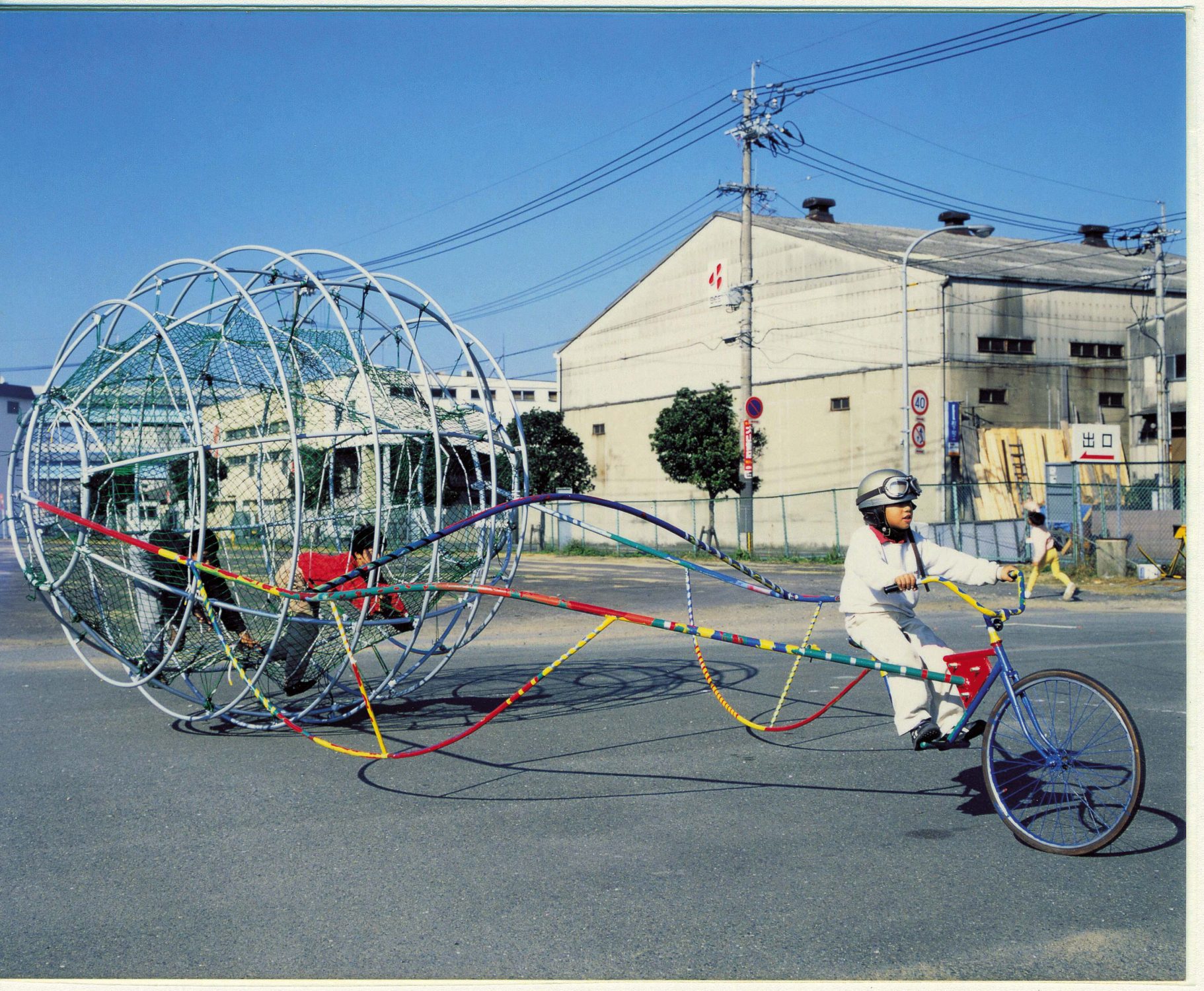
As the title “Super Suburb” suggests, the scope of their installation extended into the coastal areas far from Tenjin, including the Nokonoshima Island which was only accessible by boat and Marina-town Seaside Park. This has allowed for a greater variety of artworks, and has also made it possible to create large-scale structures by artists such as Keiichi Ikemizu. Although they were not the artists within the framework of mutual collaboration, Lee Wen wandered the streets as a Yellow-man, and Masato Nakamura held the guerrilla-like art event “Nakasu Shonen Art” in the vein of “Shinjuku Shonen Art. Fifteen artists, including Ozawa himself, participated in Tsuyoshi Ozawa’s milk box gallery, Nasubi Gallery (*23).
(*23) Although there is no detailed record or study of the events of this year, the Fukuoka City Museum has published a report of the residency and activities of the artists who participated in the 4th Asian Art Exhibition Workshop. The catalog Situations and Changes: Fukuoka Contemporary Art Chronicle 1970-2000, held jointly by the Fukuoka City Museum and the Fukuoka Prefectural Museum of Art in 2001, includes a more comprehensive description of the situation before and after the exhibition. There is also an article written by Raiji Kuroda on the Asian Art Museum’s web site, Ajibi News. In recent years, I myself have had several opportunities to talk about the year 1994.
Art Picnic (1995-1996)
I saw a video of an artist talking to children about his work, and answering to their questions. It was probably a documentation of an educational program at an American art museum. Keith Haring and another young artist (Kiki Smith?) were speaking in the video. (*24) We, too, began to think about the importance of having opportunities for direct encounters between children and artists. At that time, we were contacted by an event manager of Fukuoka Boat. They wanted to use the budget they had been spending on music shows and Sentai (Japanese task force team in TV shows) Hero events for something more educational. He offered us to use the entire venue on the days when the boat race was not being held, and I proposed a workshop featuring several artists. The “Art Picnic” continued for two years, but in the third year, the person in charge was changed, and this person was completely unmotivated, always sleeping off a hangover when I went to see him. If I could remember his real name, I would write it down here (as a memorial), but anyway, he showed no interest in the content, so we decided not to do it at Fukuoka Boat after that year.
(*24) This type of materials were sent out via the Fukuoka American Center. MCP also had been supported by the American Center for American artists, and Institut français Kyushu for selecting French artists.
Museum City Tenjin ’96 “Photosynthesis”
In 1996, after the previous exhibition in the suburb, we returned to Tenjin, and we used different locations to show the works of each artist and installed multiple works with the exception of a few artists. Only overseas artists were invited to stay and created their works. Yasumasa Morimura exhibited photographs from his “Actress Series” enlarged in the style of movie billboards with the cooperation of Yoshio Fukae, a Fukuoka-based movie billboard painter. Taira Ichikawa’s “Conditional Paradise” stood in the atrium of a commercial building and echoed with the sound of machinery. Hitoshi Ushijima established the style of public art as playground equipment. Kong Sung-Hun’s “Art Work Vending Machine” utilized cigarette vending machines, which were common in commercial facilities at the time, and sold artworks in cigarette-sized boxes, all for 500 yen. Hiroshi Fuji’s small model of Skinny-dog and Miran Fukuda’s handkerchiefs sold particularly well. Hiroshi Fuji, who relocated to Fukuoka, mass-produced a black Skinny-dog in wood carving, and developed a variety of exhibition methods, combining them with other materials according to the location. An installation using the height of the atrium to vertically bead up bowls of cup noodles was cut much shorter than originally planned due to a fire hazard. Rogue’s Gallery gave demonstrations using a Citroen, equipped with a device that amplifies the sound of the car, and also drove around the streets of Fukuoka by appointment only for the audience. Keiichi Miyagawa created a space that resembled a store called “Human Body Shop” with the theme of organ trafficking. Christine Yuki Dixon combined a Christmas tree painted black with feathers, inspired by the torture of sticking feathers on people’s bodies that was practiced in England in the past.
Jun Oenoki’s work using cameras, monitors, and computers was placed at an intersection in an underground shopping center. People caught on camera were reflected on monitors at different angles, which in turn were distributed to distant locations. I see now, I remember that this kind of exhibit was not acceptable back then – unless contained in an iron cage. FX Harsono exhibited a suspended plants artificially watered in a commercial building. That year, I had the experience of being chased by TV cameras crews for Morimura’s series of “Marilyn,” exposing her lower body exhibited in a disco, and Keiichi Miyagawa’s work using self-nudity.
Museum City Fukuoka ’98 ‘Memorealism’
In 1998, at the request of Fukuoka city, we decided to expand the scope of our activities from the existing Tenjin area to the Hakata area. For the occasion that Hakata consolidated four elementary schools into one school, we were able to rent one of them, Gokusho Elementary School, as our operation base for the period from the preparation through the duration of the exhibition. We set up our office there. Each classroom became the studio space for the artists, and the schoolyard became a venue for exhibitions and events during the exhibition. This former Gokusho Elementary School is a public school, but the land is owned by Shofukuji Temple, famous for the monk Sengai, and it stands adjacent to the temple. We were allowed to use it until 2000, when Fukuoka city changed its policy and decided to use it as an incubation facility. I proposed a plan to combine incubation with an art center, but this plan was not accepted. This was also when I began to think about the need for an art center run by MCP.
The biggest change after being based in Hakata, was that where Tenjin was a place with no residence, Hakata had an active local community with a long-standing merchant culture, so the first important challenge was to build relationships with the local community, beyond just dealing with the government, commercial facilities, and businesses, as had been the past case. We were also asked to help out with a local event called Hakata Toumyo Watching (Hakata Lantern Watching), which had been held for several years, using paper cups and Japanese paper to arrange candles along the alleys of the Hakata section of the city. In addition to taking charge of the area around the former Gokusho Elementary School surrounded by many temples, we decided to create a terrestrial painting of a dragon in the schoolyard. After much trial and error, this plan was finally materialized with Hiroshi Fuji’s idea. This method was used as a prototype, and the event was later held in all areas of Hakata, becoming an established autumn event. The collaboration of this event brought us closer to the local community.
That year, Navin Rawanchaikul returned as a participating artist. The style of his work had changed dramatically. I imagine that the experience of 1994 was significant for him. François Boisrond, an artist from France who used to draw illustrations for the Paris subway map at that time, drew a map of Fukuoka city in a bird’s eye view, compressed it, and exhibited it in the Kawabata shopping arcade. He also made illustrations of the works of all participating artists. Han Kye-ryoon from Korea exhibited his video works in three locations: at Gokusho Elementary School, a permanent video installation combining a projector and monitor, and on the large screens in the two commercial facilities; Solaria and IMS, where the video was shown occasionally between other advertisements. Michihiro Shimabuku worked with an artisan living afar, who had made an artwork on a legend at Ryuguji-Temple, where the bones of a large mermaid still remain, and displayed it inside Ryuguji-Temple. He also enlarged the old photographs of Café Brasileiro, the oldest café in Fukuoka, and displayed them in its current location. Sho Kazakura installed a three-dimensional work made from a dismantled piano in the schoolyard of Gokusho Elementary School and used it for a performance during the exhibition.
PH Studio made a small white house in which they kept installing stuffs that were gifted from the neighbour. The house itself was moved from Hakata to Tenjin during the exhibition.
Wang Jin from China engraved three different bills (Japanese Yen, US dollar, and Chinese Yuan) on three steel plates and exhibited them in front of the main office of the Bank of Fukuoka. He also exhibited his old work, a work resembling a court costume made of thick transparent vinyl sewn with fishing line, suspended in the atrium of IMS, and a new installation using vinyl in the bookstore of Iwataya Department Store. Lázaro Saavedra González from Cuba exhibited a work with a political message in the Gokusho Elementary School (a café-like setting with chairs, tables, and parasols made from deconstructed colors of the national flag) and in the Tenjin Core. (Many cubes attached to the walls extend from the faces, each connected to a speaker, and the cubes are held by large hands growing out of the floor).
“Plant Demonstration” was a group of Hiroshi Fuji, Takahiro Ogata, Akio Tokunaga, and other young artists who attempted to install the art work at the grounds of Gokusho Elementary School, in addition to the aforementioned candlelight event. Canal City Hakata, a new large commercial facility in the Hakata area, hosted a workshop by Rika Takashima and a large-scale painting exhibition based on the workshop. Ren Fukuzumi, who was a student at Kyushu University at the time and later became an art critic, participated as a volunteer when the project was based at the former Gokusho Elementary School.
WochenKlausur: Proposals and Practices through Art (1999)

That year we invited the WochenKlausur a group of artists from Vienna who did not make artworks at all. Their project was to intervene in society and to create and preserve an organization for that purpose. The members were organized according to the project, and they recruited members from Japan as well. They decided to set up an organization that would address educational issues and dispatched experts to schools. They should have established it as a non-profit organization but they never got that far. We went to the school board to propose this plan, but they brushed it off as absurd. After contacting several schools, we received a response from the principal of one elementary school who expressed an interest in trying it out. I explained to my journalist friends about the plan of which they invite kids reporter to make a page on the actual newspaper, and we got the approval from his boss, and began teaching this at the school. One day, however, his boss literally called me on the phone and said, “How could you do such a ridiculous thing? Generally speaking, it is said that a social movement called “Newspaper in Education”(NIE) began around 1989 in Japan, but it was completely unrelated in Fukuoka at that time. Whether this was what WochenKlausur members had intended or not, the organizing group for sending experts to schools, had been taken over by young members, continuing for some time afterwards. It became more a program of dispatching artists to schools, long before such program became popular in many places (*25).
Museum City Fukuoka 2000, “Art Out”
The year 2000 was the last year for the annual MCP style. We were already struggling financially, and the economic situation made it impossible to create large-scale art works (*26). In looking back, even established artists such as Keiichi Ikemizu, Navin Rawanchaikul, and Tsuyoshi Ozawa were commissioned with fairly low-cost content. On the other hand, we invited many young local artists, and the number of locations where works are installed increased considerably. Canal City Hakata had been our venue since 1998, but this time, we decreased the scale of the installations and instead, applied a new method to install relatively small-scale works throughout the entire building facility. Also at Hakata Riverain, “Teahouse of Disability” by Chiaki Wada and Unasaka Nakamura was held.
(*25) The members of this group started out with Akio Tokunaga as the director and Miki Yoshimura as the deputy director. In 2001, the name was changed to ASAP, and activities continued for a while with Tokunaga as the director and Kei Ogou as secretary general. Kei Ogou became involved in these activities after visiting a symposium in WochenKlausur.
(*26) The exhibition under the name of “Museum City Tenjin” was held in 2004, but it was different in content and on a smaller scale.
2-4 Interventions in the Urban System
Movements since 2001

Design: Masayuki Omura
Gradually, my interest shifted from art exhibitions to urban systems. I conducted several experimental projects from the viewpoint of how art can intervene in the urban system. In 2001, we operated the Art Bus in using three Nishitetsu buses circulating in the city center, wrapped with the design by artists. In addition, we produced few time-limited bus stops as a social experiment program. The bus stop in front of the Hakata-za Theater was made of wood incorporating slightly Japanese style design, while another bus stop created outdoor seating for a café. In addition, the 2002 program was not only focused on exhibitions, but was implemented as the Museum City Project “Home Room,” which was combining several other projects in addition to exhibitions (*27). We also started a project in which artists would gradually renovate the rooms in a business hotel, but unfortunately it was interrupted when the owner had changed in the middle of the project. Although bus service was not available that year, we rented a bus and invited Mutsuko Hamatake to design the wrapping and exhibited, while we also invited kids to cover the inside of the bus with their artworks. Ryuichi Sakazaki built a bus stop in conjunction with the project. In a vacant lot (the former site of Fukunichi Newspaper), several artists including PH Studio, Hitoshi Ushijima, and Kikuko Nomi participated. This was the only place that barely looked like an exhibition space. The way these events were organized was rather like a collection of events that are usually held separately, and it revealed how much we were running out of money. “Tenjin Art School” was one of the projects that began as a result of this situation.
(*27) Project names before “Homeroom” were unified with three Japanese kanji characters, but “Homeroom” was the first project name that did not have three kanji characters. This title was probably named by Hatsune Miyamoto.
Tenjin Art School (2002-2006)
Around 2000, our activities began to shift towards becoming an art center. One of the projects we undertook under the concept of “experimenting with the functions of an art center” was the “Tenjin Art School”. Based on my principle that the school should be located in the city center, I rented a conference room on the 14th floor of IMS and held a short-term intensive course lasting about one month, from October 7 to November 2, 2002. We held the entrance and the completion ceremonies and each participant received a certificate of completion. The lecturers for the first year were as follows (in alphabetical order as they appeared at the time).
Norio Ito, Sohei Imamura, Hitoshi Ushijima, Muneteru Ujino, Masahiro Ushiroshoji, ASAP, Keita Egami, Kanae Ohgi, Masashi Ogura, Takayo Kusano, Masayuki Kusumi, Raiji Kuroda, Shinji Goto, Katsuya Komagata, Kimiyo Sasaki, Yoshiko Shimada, Atsushi Suzuki, Takamasa Sumi, Wakiro Sumi, Akihiko Takami, Masamichi Tosa, Mitsunobu Nakamura, Tsuneo Nabeta, Navin Rawanchaikul, Shinichi Hanada, Makiko Hara, Maki Harada, Hiroshi Fuji, Yukio Fujimoto, Hiroyuki Matsukage, Keiichi Miyagawa, Hatsune Miyamoto , Yukinori Yanagi, Shingo Yamano, Yozo Yamaguchi, Chiaki Wada
Since June 2004, we have been commissioned by the Fukuoka City Foundation for Arts and Culture to operate the “Artelier” gallery space on the basement floor of the Shimokawabata Riverain Center Building in Hakata Ward (this is where my office has been located since then). The Art School is held not only in a conference room at IMS, but also in three different locations, including this new location. In addition, a course program was set up that year, and the lecturers were as follows.
Courses and Instructors (in alphabetical order, number of instructors: 24)
Artist Course
Sohei Imamura, Keita Egami, Naoyuki Okayama, Takamasa Sumi, Masamichi Tosa, Shigeo Toya, Jiro Hirano, Hiroshi Fuji, Heri Dono, Navin Rawanchaikul, Chiaki Wada
Management and Cultural Policy Course
Masashi Ogura, Taneo Kato, Yayoi Koga, Kojiro Suzuki, Tetsuo Yoshimura, Shingo Yamano, Hatsune Miyamoto
Theory and History Course
Chizuru Kawanami, Raiji Kuroda, Yozo Yamaguchi
Art Critic Course
Noi Sawaragi, Makoto Murata, Yoshitaka Mori
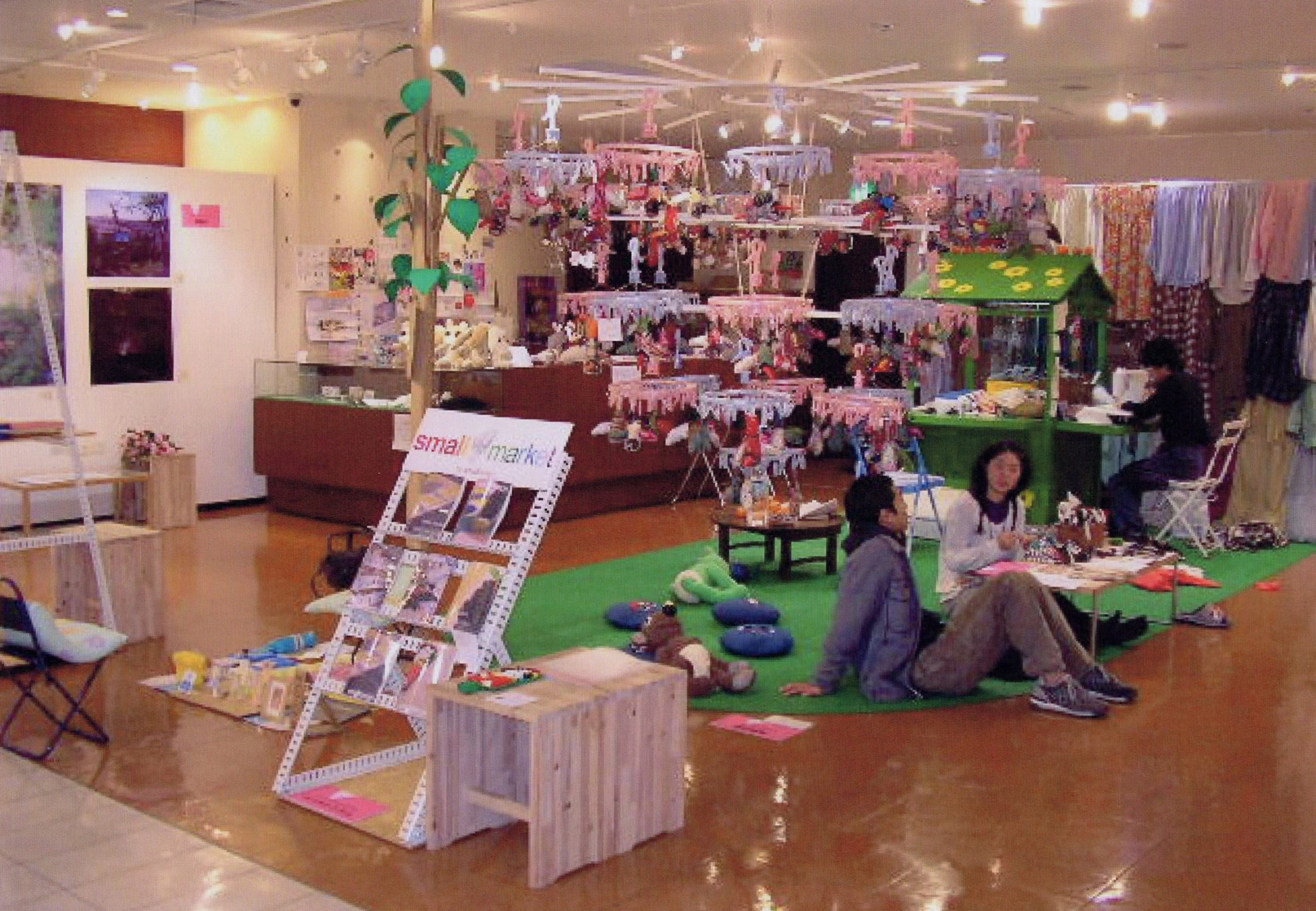
In 2006, after the Yokohama Triennale, I returned to Fukuoka. Although the name of the school remained as “Tenjin Art School”, it was also called “the Kawabata School”. In addition to the Artelier location, the Ajibi Hall in the Asian Art Museum, the Foundation’s conference rooms were all located in the same building. This year’s school was jointly sponsored by MCP, Fukuoka City and Fukuoka city cultural foundation.
Lecturers (in alphabetical order, number of instructors: 22)
Taisuke Abe, Hitoshi Ushijima, Mizuki Endo, Naoyuki Okayama, Kanae Ohgi, Hisashi Shibata, Yoshio Shirakawa, Chizuru Kawanami, Raiji Kuroda, Yayoi Koga, Koji Takeguchi, Akio Tokunaga, Katsushige Nakahashi, Masaharu Nakahara, Hiroshi Fuji, Jun Miyagi, Hatsune Miyamoto, Tsukasa Mori, Kazunobu Yanagi, Yozo Yamaguchi, Shingo Yamano, Dominique L’Huilier
Discussion on the Art Center
In March 2006, I chaired a discussion and presented “Creative Fukuoka 10 Years Plan” to then Mayor Hirotaro Yamazaki.
Unfortunately, due to his loss of the mayor election shortly after, the proposal became a worthless piece of paper. I had intended to include a message for utilizing the private sectors in the proposal. Later in June, I called on artists in Fukuoka to hold a meeting at Artelier. I explained the need for an art center, but did not get much of a response. I might not have adequately explained the need for artists. In addition, private art centers face significant challenges in terms of both space and funding. We had hoped to have a permanent center, not just events, but it was challenging to gain the understanding by the government.(*28)
(*28) According to Miyamoto’s memory, I had written a proposal to build a private art center in IMS between 1998 to 1999. This was somehow circulated to many people within the city office. Later, an officer of the foundation came to claim that my plan had plagiarized the foundation’s concept, but the cover of the foundation’s proposal he brought had my own illustration and some of the contents had been copied from my original text. I was more concerned that if the foundation implemented my art center plan, it might stifle private sector activities. I do not remember much about this. If I am merging my memory, I remembered that some agency had asked me to write a proposal for a new foundation plan as a subcontractor, and I had written it, but if so, I probably misremembered, because I would have included collaboration with the private sector in the content of the proposal. I’m sure there are others who could speak to this matter in more detail.
Projects That Did Not Come to Fruition
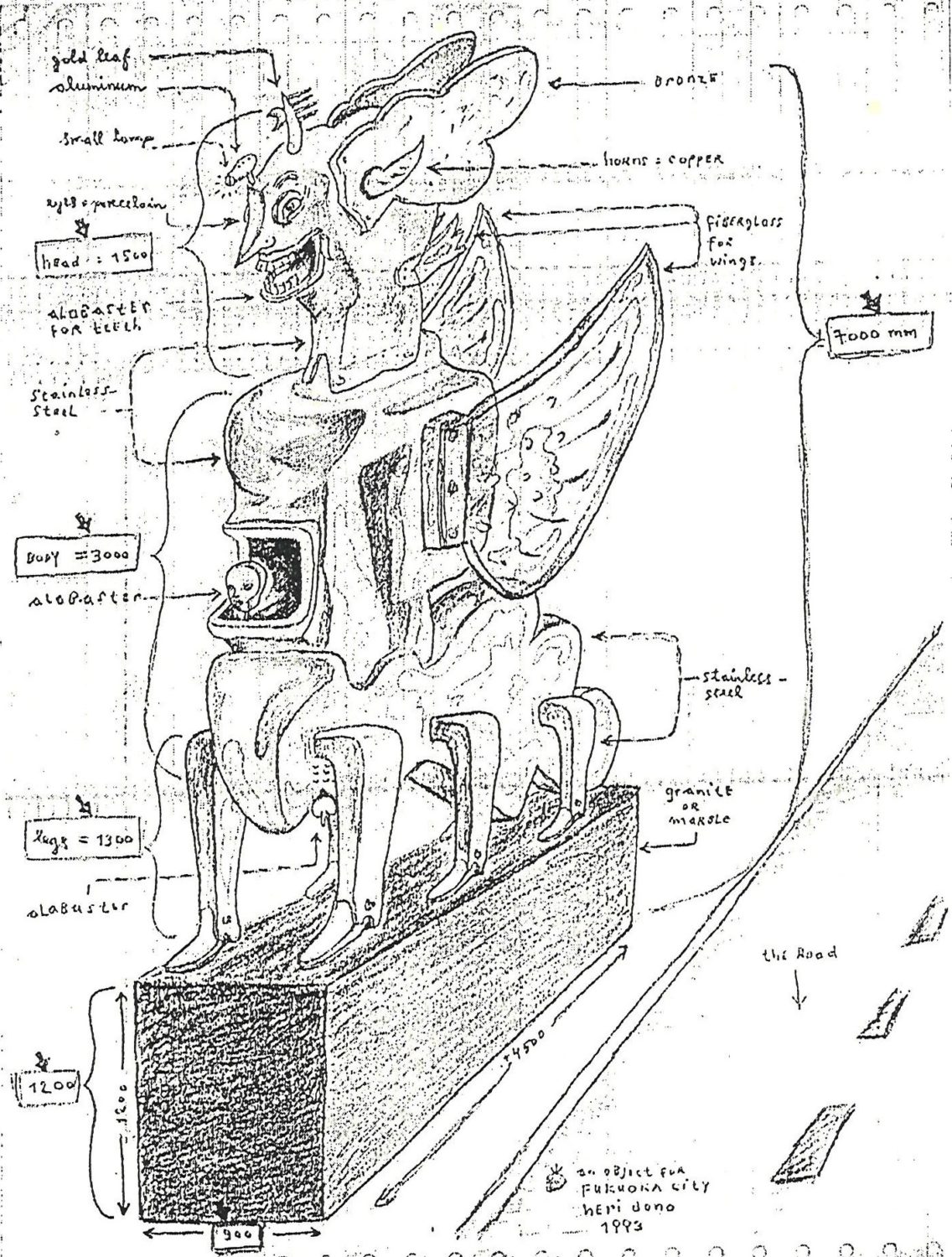
There are few projects that I have omitted mentioning. Some did not come to fruition and some did. Fukuoka city asked us to conduct a survey and make a proposal for a plan to create a city gate designed by Asian artists at the entrance of several arterial roads into Fukuoka city. I can only write vaguely for the lack of documents at hand, but I asked Heri Dono and several other artists to make plan–drawings. Based on these, I created a proposal including site conditions based on the survey. For some reason, this never developed. Also, through it was not in Fukuoka city, I was once asked to propose a public art project for a prison. When I was taking pictures of the prison wall during the site survey, I was surrounded by the guards. I proposed the idea of Sol LeWitt’s wall drawings on both the outside and inside of the wall, but it was rejected.
2-5 Yokohama
Yokohama Triennale (2005)
Toward the end of 2004, I received a call from Tadashi Kawamata, who asked me if I would be interested in taking on the role of curator of the Yokohama Triennale. (In addition to myself, Taro Amano and Takashi Serizawa were the co-curators). There was not much time for preparation. Kawamata had a plan to expand the project into the city of Yokohama, which of course was my role, but I was ignorant of Yokohama local human relations customs. I apparently made a mistake at the first entrance and was suddenly turned away in Chinatown and the gate was never opened again. Each time I tried to talk to them at the office I was told that we had never met before, Thus, I was unable to fulfill my role to expand the projects out into the city. Kawamata himself worked with government officials to secure a place.
Therefore, I would concentrate on my other role, which was to be in charge of Asia. At that time, Kawamata was not very interested in Asian art (with the exception of a few notable artists), or rather, he did not have much information about Asian art, which I think was normal for the time.
On the other hand, the Japan Foundation wanted to increase the participation from Asian countries as much as possible, and I myself wanted to introduce more Asian art. I did not have time to travel from one Asian country to another for my research. Just as I was thinking about the need of setting a goal with a strategy, I received a call from Navin Rawanchaikul of Thailand, who told me that he would be holding a symposium in Chiang Mai soon with artists and curators from various Asian countries, and that I could meet people from several countries at once if I came to the event. I hurriedly prepared for my trip.
I decided to think about the theme of my assignment after I visited to Chiang Mai. In Chiang Mai, I met with Navin, Ong Ken Sen from Singapore, Lu Jie from Long March Project in China, and a Vietnamese artist who was working on a project at a coal mine. Then I began to think about an idea of “Asian art project”. I started by creating a framework with the materials at hand, and then expanded the content by gathering knowledge from my time in Fukuoka and additional research. I remember I visited China, but I can’t recall what happened after that, and other information that I had obtained.
Behind this concept is, of course, Tadashi Kawamata’s art project method, which emphasizes the process of production and collective efforts. With that in mind, I constructed the entire project based on the hypothesis that project-based art could play a certain role in Asia, using my own experiences in conducting projects in the city of Fukuoka and the relationship between art and the community as my basic frame of reference about art in Asia.
Based on the hypothesis that art projects in Asian regions have been undergoing the process of modernization in their own ways, to link art more closely with society, cities, and local communities, I categorized these project–based art projects into some patterns through observing actual artists’ cases. Without mentioning specific names here, I saw project–based art as practices that include people to be an important part of their art–making process and oeuvre.
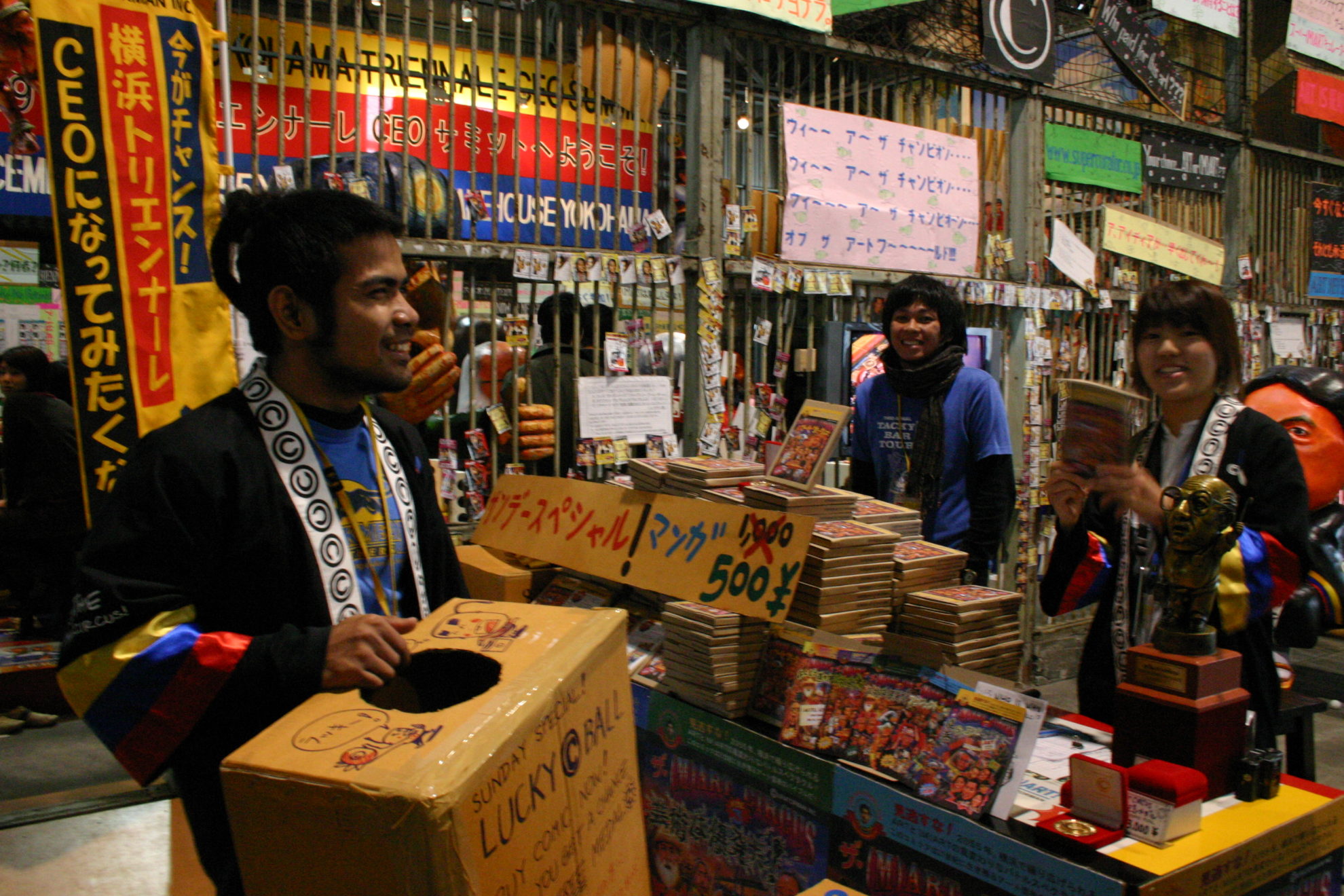
My actual exhibition turned out to be a showcase of diverse artists and groups. Ong Ken Sen participated as an organizer, curating a group exhibition called “Flying Circus Project”. Long March Project coordinated several projects by a group of Chinese contemporary artists. Navin Rawanchaikul joined with the “Curator Man” project. I also commissioned several young artists whom I met in Bangkok, Thailand to come up with a new idea as a group, and named it “SOI Project”. The “gansomaeda” duo (Gaku Tsutaja and Go Watanabe) created a system whereby visitors could participate in the Yokohama Triennale as artists for one day – if they paid 1000 yen. Taisuke Abe’s stuffed toy production project could not be completed without this day–to–day support by someone throughout the Triennale duration.
Although I thought it was an epoch-making triennial, this style was not carried on, and it ended up being an exceptional event only in 2005. It could be said that the 2008 “Koganecho Bazaar” was my attempt, in my own way, to take a portion of the Triennale and expand it into the city, which had hardly been done at the time of the Triennale.
Apart from the exhibition, a byproduct was expanding my network through research in Asia, which also led to subsequent events. Although once I had been disconnected from the Yokohama Triennale, I later became the secretary general of the Yokohama Triennale Supporters’ office for several years. Since 2011, we have been working together with the Triennale on projects such as a cooperative ticket program common to the three parties, and the Koganecho Bazaar, which is held on the same dates as the Triennale.
Intermission (2006-2007)
After the Yokohama Triennale, I returned to Fukuoka. My ties to Yokohama remained. I had an office at ZAIM (former Kanto Finance Bureau Building) on Nihon Odori and occasionally traveled back and forth between two cities. In Fukuoka, I continued to manage Gallery Artelier, a facility of the Fukuoka City Foundation for the Promotion of Culture and the Arts. During this period, I chaired two committees and submitted recommendations to Fukuoka city regarding cultural policy. In 2006, Fukuoka city offered to provide a subsidy of 2 million yen for the exhibition of the Museum City Project. I was expected to raise the remaining 10 million yen. At the meeting discussing the upcoming fiscal year, I proposed they give me the 2 million yen in advance for research in Asia and to restart the project later. Of course they said no, so I decided to decline the grant from then since then.

